
By SuperyachtNews 07 Feb 2023

Baltic Yachts co-founder Jan-Erik Nyfelt passes away
Baltic yachts have released a statement concerning the unfortunate loss of an industry legend ….
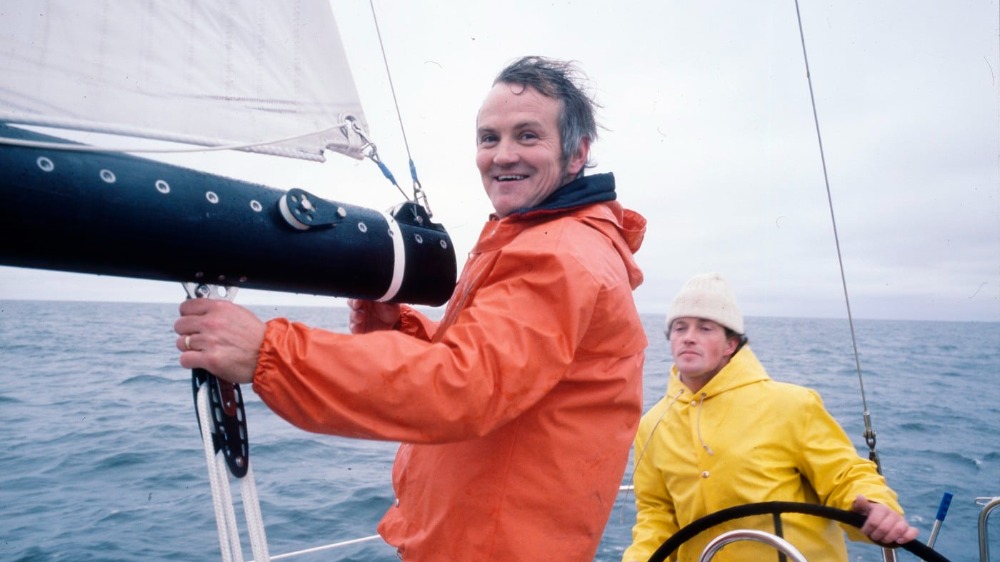
Finnish shipyard Baltic Yachts has announced the death of its co-founder Jan-Erik “Janne” Nyfelt on January 28. Nyfelt was one of the five founders of the shipyard in 1973. PG Johansson, a fellow co-founder, released the following statement on the company website:
Last Saturday, 28 January, we were reached by a very sad and shocking message. Our long-term Baltic Yachts family member, friend, colleague and one of the Baltic Yachts' original founders, Jan-Erik “Janne” Nyfelt had passed away. Baltic Yachts lost a person that has contributed greatly to what Baltic Yachts is today. A great loss for the company and for me personally the loss of a person, a friend, that I have held in extremely high regard and that has been an enormous support for me through all my years in the yachting industry.
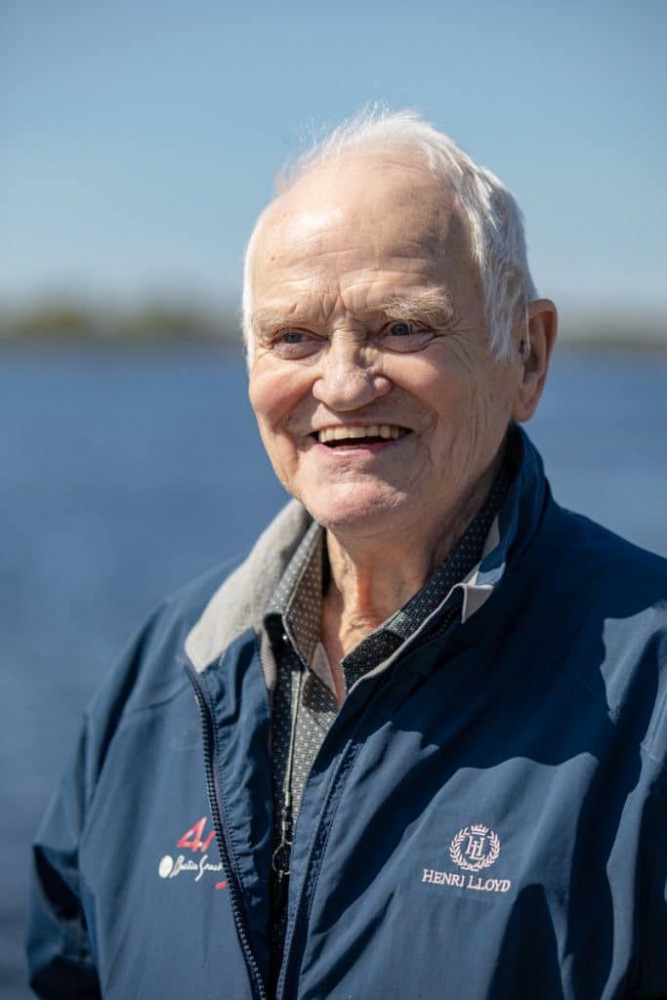
“Jannes“ career as a boatbuilder started from a very young childhood working in his father's small boatbuilding shop. Undoubtedly one of the best ways of learning the practical side of the trade. In addition to his practical yacht-building skills, he also wanted to learn more about design, calculations, making line drawings and the theoretical side of creating a boat. He worked, sometimes, for a local ship's engineer and got good insight also into the theoretical side.
He was involved in the start of Nautor, not as an owner but as a boatbuilding specialist. He was also one of the 5 persons starting Baltic Yachts and was a very active member in management and the development of our company until his retirement. His legacy to the local boatbuilding industry is invaluable.
Janne was a person that had never-ending energy always intensively involved in many things. Very keen on developing new materials and methods everything that could improve the product. Whatever he got himself involved in he was in with full energy.
He was a respected member of our Baltic Yachts family and will be greatly missed.
For me personally, he was a great support and countless times we sat together solving problems, developing new things, going through the complexity of yacht design, or just discussing life in general. There are no words enough to describe a person like “Janne”. For me, he leaves an empty space that cannot be filled but also leaves some of the best and most valuable memories one can have.
Farewell, my friend and thank you for your comradeship through the years. Our thoughts and sympathies are with his family.
Profile links
Baltic Yachts
Join the discussion
To post comments please Sign in or Register
When commenting please follow our house rules
Click here to become part of The Superyacht Group community, and join us in our mission to make this industry accessible to all, and prosperous for the long-term. We are offering access to the superyacht industry’s most comprehensive and longstanding archive of business-critical information, as well as a comprehensive, real-time superyacht fleet database, for just £10 per month, because we are One Industry with One Mission. Sign up here .
Related news
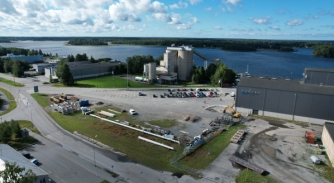
Baltic Yachts expands shipyard
Work has begun at the Jakobstad facility, which Baltic hopes to be fully operational by 2024

Europlan Yacht Interiors - the turnkey solution
The 'one-stop shop' for superyacht new build and refit fit-out in the Baltic Sea
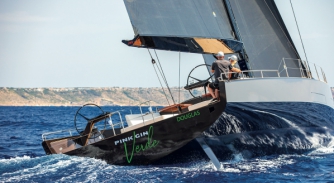
Baltic Yachts’ innovation creates the most sustainable sailing vessels
It all starts with the fundamentals...the little things that bring down consumption, reducing the amount of power and number of batteries required
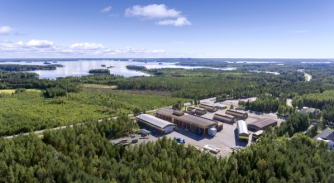
A route to a greener future
Baltic Yachts has seized the sustainability initiative in its implementation of processes and practices that resonate across every element of its operation
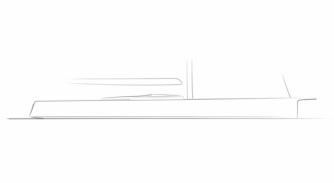
Baltic Yachts announces sale of Baltic 110
Due for delivery in 2023, the project comes at a busy time for the builder
2 years ago
3 years ago
Sign up to the SuperyachtNews Bulletin
Receive unrivalled market intelligence, weekly headlines and the most relevant and insightful journalism directly to your inbox.
Sign up to the SuperyachtNews Bulletin
The superyachtnews app.

Follow us on
Media Pack Request
Please select exactly what you would like to receive from us by ticking the boxes below:
SuperyachtNews.com
Register to comment
Founder of Baltic Yachts Jan-Erik Nyfelt passes away

According to a statement from Baltic Yachts, one of the original founders of the shipyard, Jan-Erik ‘Janne’ Nyfelt, passed away on Saturday 28 th January 2023.
The statement from Baltic Yachts reads, “Baltic Yachts lost a person that has contributed greatly to what Baltic Yachts is today. A great loss for the company and for me personally the loss of a person, a friend, that I have held in extremely high regards and that has been an enormous support for me through all my years in the yachting industry.”

Nyfelt began working on boats from a young age, supporting his father's small boatbuilding shop. Alongside developing practical skills, Nyfelt also learnt about design, calculations, creating line drawings and other theoretical aspects of creating a boat.
With these skills he was one of the early employees at Nautor Swan , where he worked as a boatbuilding specialist. He then was one of the five founders of Baltic Yachts and was a very active member in the company's management and development until his retirement.

Baltic Yachts added, “Janne was a person that had never-ending energy, always intensively involved in many things. Very keen on developing new materials and methods that could improve the product. Whatever he got himself involved in he was in full energy.”
For more information, visit Baltic Yachts.
For more news and yachting tips, connect with us on Facebook, Twitter , Instagram and LinkedIn.
Source: Superyacht Times

Tried & Tested

A jacket completes any crew member's uniform so it's an important garment to get right. In this Tried & Tested, Sea Design pits eight popular jackets against one another to determine which one is best for superyacht crew in 2023.
iAQUA creates high-performance, technologically advanced underwater scooters. In this Tried & Tested, a team of experienced testers have rated and reviewed the AquaDart Pro and AquaDart Nano series to reveal the stand-out iAQUA sea scooter.
In our 2022 Tried & Tested, yacht toy specialist EAMS and a group of captains and crew review a selection of the very best luxury water toys on the market. Find out which toy was crowned the winner...
MB92 Group and Pinmar, part of GYG Ltd, has partnered to launch a sustainability initiative in collaboration with the Ba...

The 2024 Sanctuary Cove International Boat Show (SCIBS) is set to be one of the most exciting yet, with nearly 100 launc...

Popular Articles
Finished reading now find your perfect supplier..
Search our industry-leading directory for over 20,000 superyacht suppliers, providers and marinas.

Half a century at the cutting edge

Fifty years ago in Finland five young men shared a controversial idea and an ambitious plan. They quit their jobs at Nautor and set out to create a new style of offshore cruiser racer – lighter, stiffer and faster than almost anything else on the market.

‘We just got together one day and the idea came up,’ says Per-Göran “PG” Johansson, one of the five founding fathers of Baltic Yachts back then and still one of its directors today. ‘We were not alone thinking “light is better” but most boatyards and naval architects favoured heavier designs. Some of our competitors published studies for marketing purposes arguing that heavy was better. One of their claims was “heavy does not stop in waves due to the inertia of the mass”. Another was “the client gets more kilos for his money”. We remained convinced and carried on with our lightweight, hi-tech way.’
History soon proved Johansson and his colleagues to be absolutely correct and the company they founded became a world leader in the production of large, high-performance sailing yachts.
Before any of it could happen, first they had to clear a patch of pine forest at Bosund near Jakobstad and build a shed in which to do it.
Still in use as a joinery workshop, that first shed is finally about to be decommissioned along with the whole facility that grew up around it. This year, Baltic Yachts is moving all operations to Jakobstad where a new state-of-the-art building will more than double the size of its existing waterfront location.

There’s a world of difference between the series-produced Baltics of the 1970s and the full-custom superyachts that have become the yard’s primary focus alongside its ongoing small-series, semi-custom production.
However, from the first Baltic 46 Diva (now Queen Anne) all the way to its current projects via some of the most advanced sailing yachts in each of the last three decades, the core DNA is arguably unchanged.
‘Baltic Yachts is still very much true to its original values,’ Johansson says. ‘We started as a series production yard but with more flexibility built in than most competitors, using hi-tech methods to achieve better sailing performance and handling characteristics. With time we moved over more and more to full custom projects, which required changes in our approach.

‘The projects became more individual in concept, in styling and in materials and methods used.
In that process you lose some of the things that originally earned your company its reputation. However, even our cruising projects have been very hi-tech and in that sense they’ve followed our original philosophy, “lighter is faster and better”. Some of the high-performance projects challenged us to take technology much further, increasing our know-how and potential.’
Eagerness to embrace technology prompted the founding of Baltic Yachts in the first place. Johansson was project manager of the Swan 65 when he tried and failed to convince his managers that it could be built lighter, stiffer and better using sandwich construction with unidirectional fibres instead of a single laminate with woven rovings.
The five who left Nautor – boatbuilders Jan-Erik Nyfelt and Nils Luoma, purchasing manager Ingmar Sundelin, designer Tor Hinders and Johansson – became the nucleus of Baltic Yachts.
Baltic Yachts – major milestone boats 1974-2022

1974 Baltic 46 Ahead of its time: tank tests, sandwich construction, unidirectional fibres, balanced spade rudder, epoxy bonded teak deck…
1977 Baltic 39 Most popular model, 74 in six years. From 1980, one of the first yachts to have computer-generated VPP
1979 Baltic 51 Notable for interior design innovations. First double-berth cabin under an aft cockpit, slanted bulkheads for optimal use of space

1982 Baltic 80 Midnight Sun Baltic Yachts’ first maxi racer and one of the first maxis with full glassfibre composite construction.
1985 Baltic 43 Bully The first offshore sailing yacht in the world built entirely with epoxy resin
1996 Baltic 67 Aledoa The first cruising yacht built entirely in pre-preg carbon
1996 Baltic 87 Anny First Baltic with a lifting keel, complex hydraulics and push-button sail controls
1997 Baltic 70 Vittfarne First Baltic yacht to combine classic appearance with hitech construction and modern hydrodynamics

1997 Baltic 70 Loftfari The first yacht with a fully fitted interior built entirely in pre-preg carbon and Nomex honeycomb, all invisible under the teak veneer finish
Baltic 78 Super Baltic 5 Canting keel with its entire mechanism under the cabin sole; 3.5kts faster than the same yacht with a fixed keel
2002 Baltic 147 Visione The first superyacht capable of planing at 30 knots. Packed with unique innovations, ultra-light displacement (105T) and almost literally no expense spared
2003 Baltic 141 Canica A very complex build and fitout with hi-tech materials, construction techniques and systems. The first Baltic ‘super cruiser’
2011 Baltic 197 Hetairos Largest carbon composite sailing yacht in the world at 221ft LOA. Classic look, superb finish. Hi-tech build and hydrodynamics

Baltic 175 Pink Gin The largest full carbon sloop in the world to date. Unique fold-down, through-hull platforms in the saloon and owner’s suite
2019 Baltic 142 Canova First DSS foil on an ocean cruising superyacht. First hybrid drive with full regeneration. Advanced composite engineering. A giant leap into the future
2022 Baltic 68 Pink Gin Verde First Baltic yacht built with 50% flax fibre. Advanced electric/hybrid propulsion, super efficient systems
‘They had a strong belief in themselves, courage to swim upstream and test new ideas,’ Baltic Yachts’ marketing manager Elisabet Holm explains. ‘They all had a passion for boats, a strong driving force to learn new things and research technology, and they were always ready to meet new challenges.’
The original Baltic 46 was far ahead of its time. At a time when nearly all new designs simply relied on the naval architect’s eye, experience and intuition, several different hull models were tank tested across a range of speeds, at various heel and leeway angles before the design of the 46 was finalised and only then was it built. It had a balanced spade rudder and solid rod rigging, which were then used only on hi-tech racing yachts and its teak deck was laid with epoxy resin. But the hull laminate itself was the key innovation.

‘In those days most yards building larger yachts used woven rovings with fibres bent, not straight, hence not structurally optimal and they also resulted in resin concentration,’ Johasson explains.
‘You could see the roving patterns on the surface, due to resin shrinking, so before applying the rovings they used several layers of chopped mat, which has very low structural value, especially on larger yachts, but added a lot of weight.
‘We used a very thin surface cloth and the rest of the laminate was unidirectional fibres, oriented in the direction of the stresses and perfectly straight, hence stronger and stiffer.
‘The fibres we used did not create resin concentration so there was less print-through on the hull surface. Unidirectional does not build up thickness like woven rovings so we used them with a core material in sandwich construction. This achieved much higher panel stiffness than a single laminate and gave us more flexibility for panel sizes.’

End grain balsa was the core for the 46 but Baltic soon switched to foam cores with a variety of densities and strengths. Carbon fibre was used from 1979, initially in rudder posts, beam tops and to reinforce high-stress areas of the hull where extra stiffness was needed. As stabilised foams for high-temperature cures and then Nomex for pre-preg carbon construction became available, Baltic pioneered the use of those materials.
Baltic Yachts’ early achievements belie the fact that it faced strong headwinds right from the start. 1973 was a bad year to launch a new brand of sailing yachts, with the global oil crisis looming.
The yachting industry as a whole was hit hard and by 1977 Baltic had to seek outside investment to stay in business. Ironically that same year saw their first major commercial success, selling 12 Baltic 39s at the Hamburg Boat Show, which was unheard of at the time.
Hollming, a Finnish shipbuilder, acquired Baltic. Two of the founders, Nils Luoma and Ingmar Sundelin, quit but the takeover turned out to be a positive move. Hollming provided stability and investment to help Baltic grow. A huge production hall was built, funds were provided for new model development and marketing.

An unusual aspect of Baltic Yachts that undoubtedly worked in its favour was the dual role of Johansson. It’s rare that the technical guru of a major boatbuilder is also its head of sales and marketing, yet he combined both jobs with great success for 40 years.
Even now, though officially retired, he still frequently offers a guiding hand in the development of new projects and the current EVP, Henry Hawkins, describes him as ‘an unbelievably useful sounding board and wise head’.
Baltic’s in-house designer Tor Hinders made his mark by changing the way boats are fitted out down below. His stand-out innovation, which was met with hostility when introduced in 1979 on the Baltic 51 but has since been copied by almost every sailing yacht builder in the world, was to put a double-berth cabin under an aft cockpit.

Another key factor in Baltic Yachts’ early success was its partnership with the Canadian naval architects C&C Design, whose chief engineer Rob Ball was among the first in the industry to start using computers. From 1980 he supplied VPP – polar curves and tables of numbers – for the Baltic 39, 51 and 37, with detailed instructions on how to use them. Despite being generated by 2D computing (as 3D models were not yet available), Johansson says those first VPP numbers were accurate and useful.
The yard was quick to develop its own computing expertise. ‘As soon as programmable calculators and then the Epson HX-20 computer became available we saw their potential and started to use them,’ Johansson says. ‘There was no software so we did our own coding.’ By the early 1980s they were already using these tools for displacement, flotation and trim calculations, laminate design and rating optimisation.
A huge quantity of data has been compiled since then and the initially simple programs have evolved into a sophisticated suite of software that enables the technical team to make extremely detailed weight and load calculations for the hull and rig of any new design, study engine power, prop pitch and range for electric and conventional propulsion systems, and much more. The yard has never had any ambition to design its own yachts, but is quite often asked by clients to do preliminary studies before a naval architect is appointed.

The 1980s were the peak of series production but Baltic Yachts but they also began pushing the boundaries of performance with custom builds with more scope for creative technical development.
‘A series production model is always to some degree a compromise,’ Johansson says. ‘On custom projects you can take things much further. For very knowledgeable clients looking for performance we have taken things to the edge.’
The 80ft Midnight Sun was one of the first maxis with full composite construction, launched in 1982. ‘The forward part was a large, empty sail store and we used specially designed longitudinal bulkheads and framework in the upper corner between hull and deck to create the required stiffness,’ Johansson recalls.
The Baltic 43 Bully was the first offshore yacht built entirely in epoxy resin, in 1985. In technical terms this was a spin-off from an earlier R&D project, developing ultra-strong vacuum-infused sandwich laminates for a Soviet deep-sea submarine, which ruffled diplomatic feathers when the Americans found out about it. ‘The main unit was solid steel; we built a streamlined cover around the equipment,’ he says. ‘If you send a normal laminate down to 6,000m it will not be the same afterwards. We learned a few things from that project.’

In 1990, Baltic regained its independence. Finland’s industrial sector was in recession and Hollming needed to focus on its core business. ‘They asked us to arrange a management takeover,’ Johansson explains. ‘The yard was an important workplace for the local community and to shut it would have been very destructive. We were 32 employees who got together, took over and continued the business.’
Marketing manager Lisbeth Staffans stepped up to be managing director and led Baltic Yachts for two decades from a challenging start. ‘With a bad order book and uncertain future there were sleepless nights at the beginning of this new era,’ Johansson says. ‘Lisbeth was a very good person for that job. We couldn’t afford to make any mistakes and she made sure we didn’t. But this period is the one I’m most proud of. We did a good job, moved up in the size of our projects and stayed profitable.’
Innovation continued apace with production manager Christer Lill running a remarkably tight operation as the yachts ramped up rapidly in sophistication and size. In 1996 they launched 67ft Aledoa, the world’s first pre-preg carbon cruiser, and 87ft Anny – their first with a lifting keel, twin rudders and complex hydraulics. She had full push-button sail controls and a tender could be driven straight into the automatic opening-andlowering garage in her stern.

The following year, the Baltic 70 Vittfarne heralded a new style of yacht combining classic appearance and fine traditional craftsmanship with hitech construction, light displacement and modern hydrodynamics. ‘Bill Dixon’s team did a fantastic job on the design and our carpenters performed magic in building it,’ Johansson says.
Another Baltic 70, also launched in 1997, took carbon composite sandwich construction to a new level. The fully fitted interior of Loftfari was built almost entirely in pre-preg carbon/ Nomex honeycomb as well as her hull and deck, saving a large amount of additional weight.
It looked traditional, though, with thin veneers and fillets of teak covering all of the composite surfaces. Most Baltic yachts are now fitted out in a similar way.
The 78ft Super Baltic 5, delivered in 2000, was a major feat of engineering with a canting keel whose entire mechanism was installed in the shallow bilge beneath the saloon sole. She was calculated to be at least 3.5kts faster than an identical yacht with a fixed keel.

At the turn of the millennium Loftfari’s owner came back to Baltic with an impossible design brief, ‘or so it seemed at first,’ Johansson says. ‘To build a yacht in excess of 140ft capable of planing at 30 knots or more.’
The project was an immense challenge, not least because their largest build up to then was a 97- footer. Two years of development work followed before the owner gave the green light for the build to proceed. Remarkably the yacht was delivered six months ahead of schedule and exceeded all expectations.
Packed with unique innovations and with almost literally no expense spared, the Baltic 147 Visione was far ahead of her time and despite being 20 years old she is still quite capable of taking line honours in superyacht regattas today.
In build at the same time, the 141ft Canica challenged the yard in different ways. Performance was key but a lot of equipment and systems were also required to ensure a very high level of comfort on board. ‘That was the first yacht we built with a full floating interior,’ Baltic sales director Kenneth Nyfelt, son of founder Jan- Erik, explains.

‘We installed a highly complex Siemens PLC monitoring and control system, and it was the first project where we used noise and vibration consultants.’ With half the displacement of a typical 140ft cruising yacht, the performance targets were achieved and Canica can now be regarded as the first in a gradually evolving style of high-performance Baltic ‘super cruisers’ that continues to this day. A similar and parallel evolution of successful cruiser-racers began with Nilaya in 2010.
A stand-out project delivered in 2011, at 221ft LOA the Baltic 197 Hetairos is largest carbon composite sailing yacht in the world. A true wolf in sheep’s clothing with an incredible sail area : displacement ratio and a regular winner in superyacht regattas, the 60-metre ketch is classic on deck but thoroughly modern below the waterline with a unique lifting rudder as well as a lifting keel.
Around this time, the people who had staged the 1990 management takeover began to retire so new owners were needed. Two local investors bought shares in 2010; three years later an 80 per cent stake in Baltic Yachts was acquired by the German family-owned company Otto Bock – led by Professor Hans Georg Näder, a longstanding client of Baltic Yachts – and its future was secured. Henry Hawkins, a yacht captain with vast practical experience including many thousands of ocean miles as skipper of Näder’s yachts, joined Baltic, taking on a large part of Johansson’s role.

Näder’s own 175ft Pink Gin VI is one of the most notable recent builds and currently the world’s largest carbon composite sloop with a rig 16m taller than a J Class. Her key features include fold-down platforms in her topsides just above the waterline that are large enough to walk through, one amidships in the main saloon and one forward in the owner’s suite.
While relatively easy to build on a large motor yacht, putting large apertures in highly stressed parts of a sailing yacht hull without reducing its stiffness was a major engineering challenge, solved by mechanically locking the platforms firmly in place to become structural parts of the hull.
Another recent showcase of Baltic’s innovation is the 142ft Canova, which made headlines in 2019 as the world’s first superyacht with a DSS foil to reduce pitching and heeling, plus a host of other advanced features such as an immensely strong coachroof with a featherlight look and an electric drive system that provides enough regeneration capability under sail to cross the Atlantic without using any fossil fuel – with both sailing and hotel systems running.
After four years of cruising, a wide range of what used to be bleeding-edge technologies are now proven to work reliably.
To mark Baltic Yachts’ 50th anniversary, the first Baltic 46 Queen Anne returned to the yard last spring for a refit. Two of the men who built her – Johansson and Jan-Erik Nyfelt, whose grandchildren now work at Baltic – were delighted to find her in excellent condition, which a survey duly confirmed.
‘No structural works are needed, the hull appendages are sound, as is the mast,’ Hawkins says. ‘It’s also interesting that the original propulsion setup was still operational and in good order. The enjoyment at our end was the size of everything compared to today, from fibre technology to deck fittings. There are 18 winches on that boat; a modern 100-footer uses just seven or eight!’ She will be relaunched in June after a cosmetic refit, with a new engine.
What direction is Baltic Yachts likely to take in the future? The 68ft cruiser-racer Pink Gin Verde might hold a few clues with its 50 per cent flax fibre hull and micro-turbine hybrid propulsion system, but as Baltic’s CEO Anders Kurtén puts it, ‘That all depends on where our customers want to take us.’
‘We are fortunate and honoured to build some of the most exciting, groundbreaking custom sailing yachts in the world which means the next major milestone will forever be the next launch, summer 2023 being a perfect example,’ he says. ‘My best guess for the future is ever increasing sustainable practices and yachts with diminishing lifecycle emissions, as well as quantum leaps in terms of pure sailing performance.’
Click here for more information on Baltic Yachts
You are using an outdated browser. Please upgrade your browser to improve your experience and security.
Marine Industry News
- Leisure Marine
- Maritime, Commercial & Defence
- Boats and Outboards
- Construction Materials
- Engines and Propulsion Systems
- Marina and Yard
- Marine Electronics
- Safety Equipment
- People on the move
- Shows & Events
Baltic Yachts co-founder Jan-Erik Nyfelt dies
Wednesday, February 8th, 2023
Written by: Marine Industry News
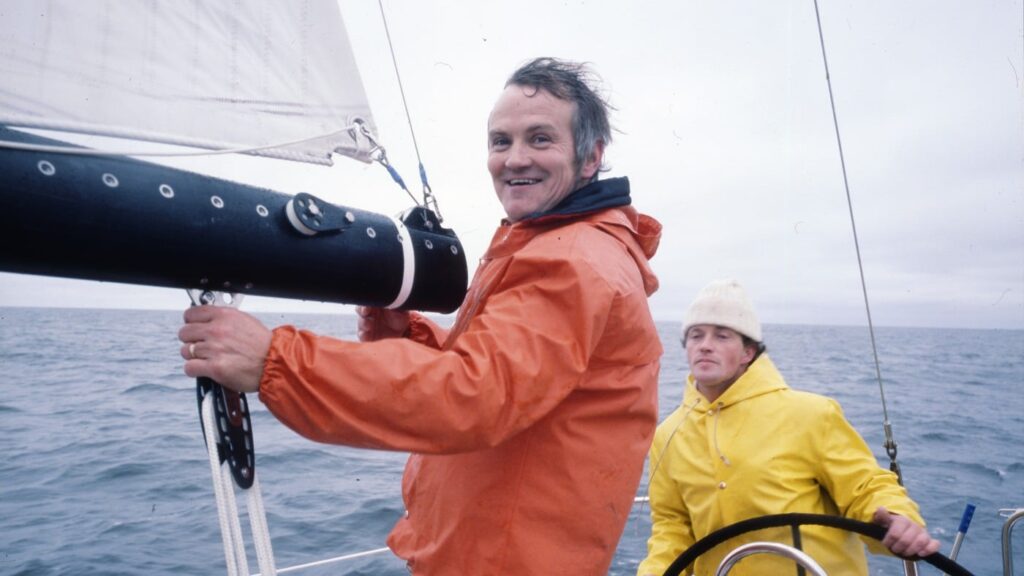
Jan-Erik Nyfelt, known as “Janne” to his colleagues, passed away on January 28 2023.
Nyfelt was one of the five co-founders of the Finnish shipyard Baltic Yachts and remained a very active member of the firm until his retirement.
“Baltic Yachts has lost a person that contributed greatly to what Baltic Yachts is today,” says fellow founder Per-Göran ‘PG’ Johansson in a statement published on the Baltic Yachts website.
“[It is] a great loss for the company and for me personally the loss of a person, a friend, that I have held in extremely high regard, and that has been an enormous support for me through all my years in the yachting industry.
Nyfelt’s career as a boatbuilder started from a young age, working in his father’s small boatbuilding shop. In addition to his practical yacht building skills, he also wanted to learn more about design, calculations, making line drawings and the theoretical side of creating a boat. For some time, he worked for a local ship’s engineer and gained insight into the theoretical side of boatbuilding.
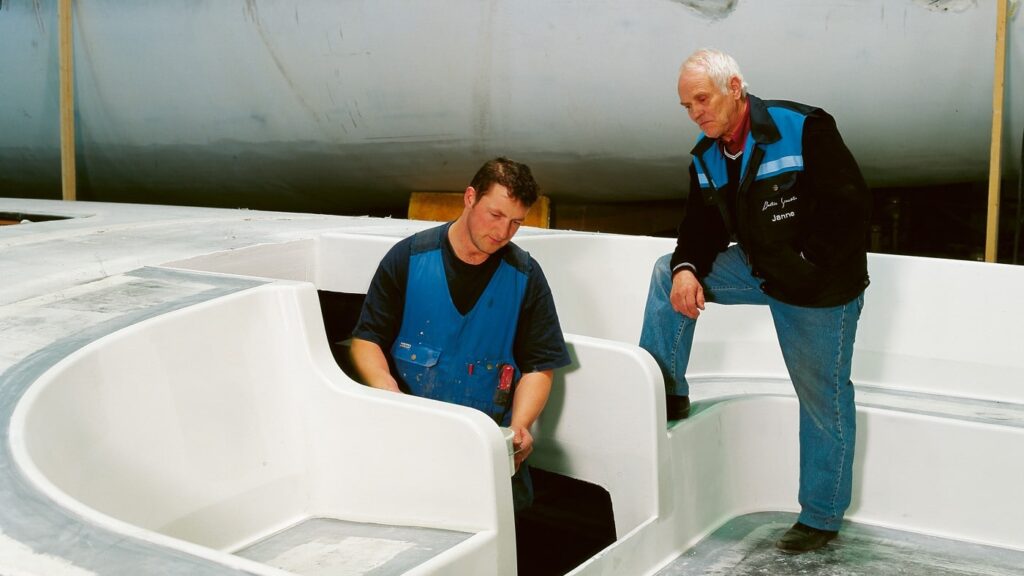
Johansson recalls that Nyfelt was involved in the start of Nautor as a boatbuilding specialist. “He was also one of the five people [who] started Baltic Yachts and was a very active member in the management and development of our company until his retirement,” he continues. “His legacy to the local boatbuilding industry is invaluable.
“Janne was a person with never-ending energy [and] always intensively involved in many things. [He was] very keen on developing new materials and methods: everything that could improve the product. Whatever he got himself involved in he was in with full energy.
“He was a respected member of our Baltic Yachts family and will be greatly missed.”
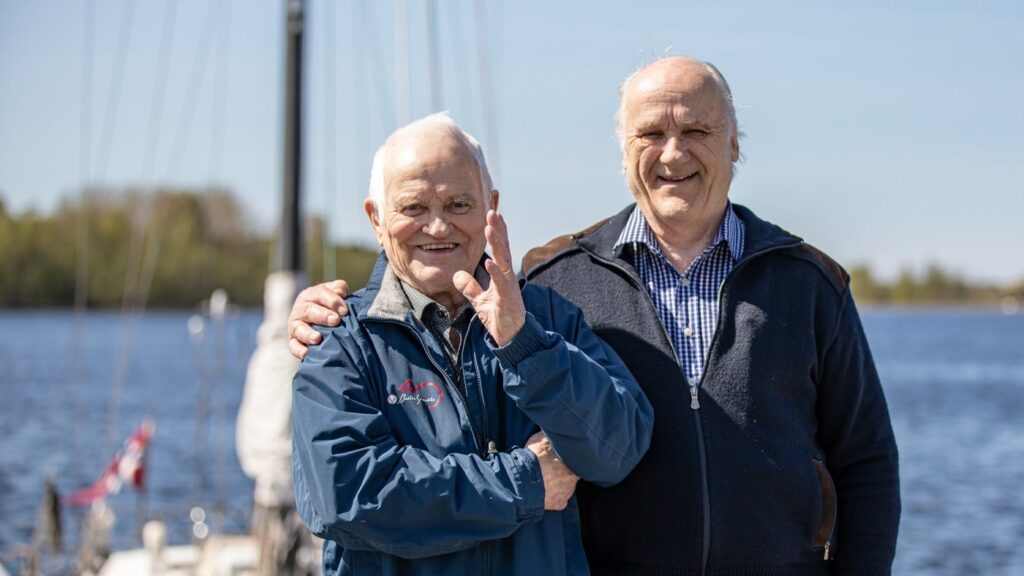
First Silent 60 launched at new Italian shipyard
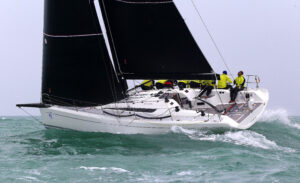
Italia Yachts brand coming to the UK
Comments are closed.

MIN magazine
Dive into MIN’s print edition which is now online for your convenience. More stories, more in-depth features, more product news and more exclusive interviews. Enjoy thoughtful analysis of the marine trade sector from across the world and get onboard with new trends.

Privacy Overview

The global authority in superyachting
- NEWSLETTERS
- Yachts Home
- The Superyacht Directory
- Yacht Reports
- Brokerage News
- The largest yachts in the world
- The Register
- Yacht Advice
- Yacht Design
- 12m to 24m yachts
- Monaco Yacht Show
- Builder Directory
- Designer Directory
- Interior Design Directory
- Naval Architect Directory
- Yachts for sale home
- Motor yachts
- Sailing yachts
- Explorer yachts
- Classic yachts
- Sale Broker Directory
- Charter Home
- Yachts for Charter
- Charter Destinations
- Charter Broker Directory
- Destinations Home
- Mediterranean
- South Pacific
- Rest of the World
- Boat Life Home
- Owners' Experiences
- Interiors Suppliers
- Owners' Club
- Captains' Club
- BOAT Showcase
- Boat Presents
- Events Home
- World Superyacht Awards
- Superyacht Design Festival
- Design and Innovation Awards
- Young Designer of the Year Award
- Artistry and Craft Awards
- Explorer Yachts Summit
- Ocean Talks
- The Ocean Awards
- BOAT Connect
- Between the bays
- Golf Invitational
- Boat Pro Home
- Pricing Plan
- Superyacht Insight
- Product Features
- Premium Content
- Testimonials
- Global Order Book
- Tenders & Equipment
Baltic Yachts Yachts
Baltic Yachts made a reputation building high-tech, semi-custom sailing yachts, but in recent years, it has launched a fleet of custom superyachts by noted naval architects and designers.
Baltic Yachts History
In 1973, five young yacht builders defected from the well-known Finnish shipyard Nautor’s Swan and formed their own company, Baltic Yachts, in the Bosund region of western Finland. Their goal was to become a niche builder of high-quality, high-tech sailing yachts for performance-oriented racing and cruising sailors. To staff their shipyard, they drew from local talent in the region; a shipbuilding centre since the 16th century. The founders’ goal was to build sailing yachts that were “faster, stronger and lighter” than the competition utilising exotic construction materials including carbon fibre and high-tech yacht-building method.
After launching the Baltic 46 and 33 production sailing yacht series, Baltic Yachts delivered its first custom yacht in 1975. Two years later, the shipyard was acquired by Finnish shipbuilder Hollming Ltd., enabling it to expand its marketing efforts worldwide. In 1991, ownership of Baltic Yachts passed back into the hands of key staff members. Today, the principal shareholder is Hans Georg Näder a German industrialist, passionate sailor and serial yacht owner. The shipyard offers semi-custom and custom sailing yachts up to 60+ metres in length
Notable Baltic Superyachts
In 2011, Baltic Yachts launched its largest superyacht to date, the 66.7-metre (including bowsprit) Hetairos . Featuring high-tech carbon construction, Hetairos was co-designed by Dykstra Naval Architects and Reichel Pugh Yacht Design .
Yacht designer German Frers designed the light and lithe, 32.64-metre sloop Inukshuk , which Baltic Yachts delivered in 2013. Inukshuk has a telescoping keel that lowers from 3.35 metres to 4.85 metres and an exceptional power-to-weight ratio. The yacht received two ShowBoats Design Awards and Sailing Yacht of the Year from the World Superyacht Awards in 2014.
The 108-foot Javier Jaudenes design WinWin swept the awards tables in 2015 grabbing a pair of prizes each from judges of the ShowBoats Design Awards and World Superyacht Awards, as well as top yacht in the 24- 40m category of the International Superyacht Awards. The following year, 115 foot Nikata from the boards of Judel-Vrolijk and Nauta Yachts captured four ShowBoats Design Awards, a Judges Special Award for Design and Performance at the World Superyacht Awards and Best Sailing Yacht in the 24-40m category from the International Superyacht society
In 2016 Baltic delivered the high performance 130 foot My Song designed by Reichel Pugh and Nauta Yachts to owner Pier Luigi Loro Piano. The yacht, in addition to being a podium finisher at many regattas, received 2017 prizes from the World Superyacht Awards, the ShowBoats Design Awards (2) and the International Superyacht Society. The yacht was involved in an accident while being transported in 2020 and declared a total loss.
Baltic’s 54 metre Pink Gin VI is the world’s largest carbon fibre sloop. Built for the yard’s principal owner, the 245-ton, silver sloop features a 71-ton, two-stage lifting keel, a 67.9m carbon fibre Rondal mast and two fold-out terraces. Naval architecture is by Judel-Vrolijk & Co and interior design and styling by Design Unlimited . Pink Gin VI took the WSA title of Sailing Yacht of the Year in 2018.
The 43.3m Canova , a Farr Yacht Design project that features a sliding horizontal foil from Dynamic Stability System, was launched in the summer of 2019. Canova won the World Superyacht Awards sailing yacht of the year title in 2020 and Best Naval Architecture prize from the Design & Innovation Awards judges. In addition to the largest-ever application of the DSS foil, the yacht also features diesel-electric propulsion and a hydro-generator system, all intended to make her greener, quieter, more comfortable and easy to maintain.
Also launched in 2019 was the 34.14 metre Liara designed by Malcolm McKeon and Adam Lay for cruising and occasional regatta sailing. Liara took a Boat International Design & Innovation Awards for both Exterior Styling and Interior Design in 2020
RELATED ARTICLES

Yachts for sale
Yachts for charter, specialisations.
Baltic Yachts operates yards in Jakobstad and Bosund, Finland, where it builds new luxury sailing yachts. It also has a service facility in Palma de Mallorca with a 1,000-tonne lift that provides “lifecycle services” including yacht maintenance and refit work including paint, plumbing, carpentry and electrical.
Baltic unveiled a motor yachts division in January 2017 with designs for the 27-metre Baltic MY88, 34-metre Baltic MY112 and 41-metre Baltic MY135; and a Day Boat range with the 15-metre Baltic MY49 and 17-metre Baltic MY56. Its first motor yacht, a 78 footer designed by Mani Frers and called Bill and Me , delivered in July 2017.
Yacht Features
Propulsion System
- International edition
- Australia edition
- Europe edition

Meet the oligarchs: the Russian billionaires whose jets, yachts and mansions are now in the crosshairs
Some of Russia’s super rich are finding their assets in the west under threat of sanctions from the US
For a growing number of Russia’s richest and most powerful men, now would be a very bad time to take their private jets and superyachts to their mansions in the United States.
Yesterday, the White House announced it would expand the list of Russian oligarchs subject to full blocking sanctions – the highest level of restrictions – as it ramps up punishment against Russia for its invasion of Ukraine. Some of the newly named oligarchs overlapped with a list of Russian elites on whom the European Union imposed sanctions earlier this week, although there were some notable differences.
The federal government won’t just stop at freezing these targets’ assets, but will seize them, Joe Biden announced in his State of the Union address on Tuesday.
In charge of appropriating these assets will be KleptoCapture , a newly announced justice department taskforce, with support from the treasury department, FBI, IRS and other federal agencies. Under US law, the justice department may use civil forfeiture to confiscate the proceeds from foreign crimes, including corruption, when they are found in the United States.

Their efforts will complement those of a transatlantic taskforce announced over the weekend between the United States, France, Germany, Italy, the United Kingdom, Canada and the European Commission.
“We are joining with our European allies to find and seize your yachts, your luxury apartments, your private jets. We are coming for your ill-begotten gains,” Biden said.
The Feds may have their work cut out. US regulations are lax when it comes to requiring disclosures of real estate transactions by foreign individuals, making the country a prime destination for Russian’s uber-rich looking to snap up prime properties without scrutiny.
Other favorite toys of oligarchs like planes and boats are commonly registered through shell companies. And many of those luxury craft have begun traveling toward extradition-free territories such as the Maldives, according to Bloomberg News .
Here’s an introduction to the Russian oligarchs now joining the US sanctions list – as well as a few others who haven’t been targeted yet, but have notable US ties.
Alisher Usmanov
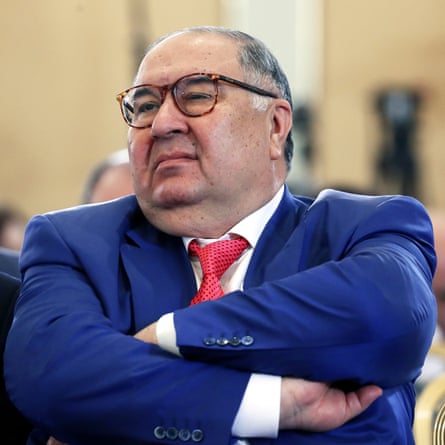
Russians know Alisher Usmanov as one of Vladimir Putin’s “favorite” oligarchs. The country’s richest man until 2015, Usmanov owns a majority stake in Russia’s second-largest phone network, MegFon, and a large stake in the iron and steel giant Metalloinvest.
But few Americans know that Usmanov also helped give us Facebook. The billionaire began investing in the social network in 2009, when Zuckerberg’s firm was having trouble accessing funding in the wake of the financial crisis. Usmanov ultimately poured over $900m into the firm, owning as much as 10% of the company before selling his stake in 2014 and netting himself billions. He was also a major investor in Apple, Twitter, LinkedIn, Groupon and Zynga.
Usmanov was subjected to sanctions by the EU on Monday, and on Wednesday German authorities seized his $600m megayacht , the Dilbar – which boasts the world’s largest yacht-based indoor swimming pool. On 3 March he was among those added to the sanctions list by the US. The oligarch still has a $200m private Airbus A340.
The Rotenbergs
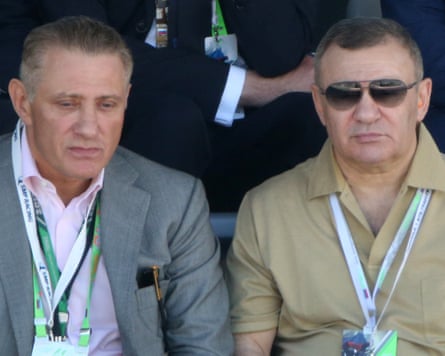
Long before brothers Arkady and Boris Rotenberg became two of Russia’s wealthiest tycoons, they were teenage Vladimir Putin’s judo training buddies, a role they continued into adulthood. Clearly they were good at it, because after Putin became president he rewarded the brothers with the control of large state-owned enterprises and lucrative contracts, netting them a massive fortune.
The Rotenbergs have since built a huge family empire of international investments under a web of shell companies, which has made Arkady’s son Igor a billionaire in his own right. Despite Arkady and Boris getting US sanctions after Russia’s 2014 invasion of Crimea, the brothers “continued actively participating in the US art market by purchasing over $18 million in art in the months following the imposition of sanctions”, according to a US Senate report . Rotenberg-linked shell companies continued making transactions in the US financial system worth over $91m long after the sanctions, according to the report.
In addition to Arkady and Boris, Igor and five additional family members were added to the US sanctions list this week.
Igor Shuvalov
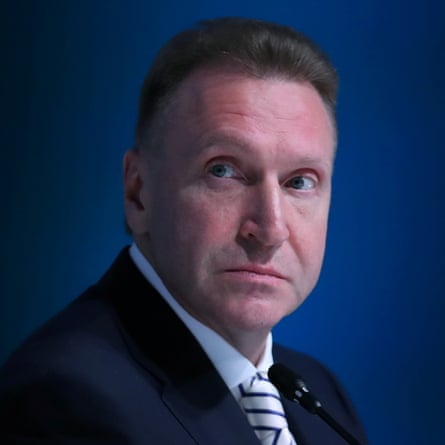
Russia’s deputy prime minister from 2008 to 2018, Igor Shuvalov is now the chairman of VEB, the Russian development bank that finances major infrastructure projects, including the Sochi Olympics. He has claimed to be one of Russia’s cleanest officials, telling media he transferred all his wealth to Russia in 2013, and only kept it offshore before that to avoid spoiling his kids . But an investigation by the anti-corruption activist Alexei Navalny found that Shuvalov, through a shell company, bought two London luxury apartments in 2014 for $11.4m and has used a secret private jet to fly his wife’s corgis around the world because, as one of his staffers explained, “it’s not that comfortable in business class”.
He won’t be able to fly his corgis as many places now that he’s on the US and EU’s sanctions lists.
Yevgeniy Prigozhin
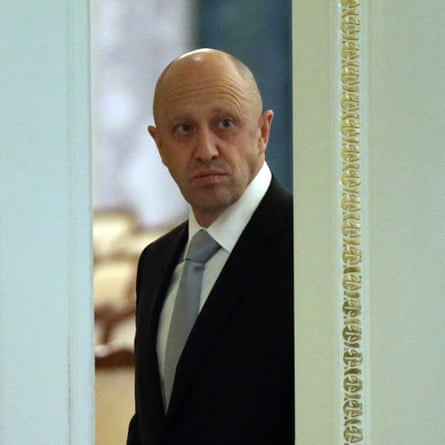
Legend has it Yevgeniy Prigozhin began his rise to power selling hot dogs , shortly after getting released from prison for robbery. The wiener venture was apparently a smash hit, and within years he had opened high-end restaurants that counted Russia’s leader among their clientele, earning him the nickname of “Putin’s chef” and catapulting him into the inner circles of Russia’s elite.
Americans might be more familiar with another one of Prigozhin’s businesses: the Internet Research Agency, which employed a troll army that began by supporting Russia’s 2014 invasion of Crimea, before turning its efforts to influencing the 2016 US presidential election in favor of Donald Trump. Prigozhin and the Internet Research Agency were indicted by a US grand jury in 2018 for interfering with the election, and he was added to an FBI wanted list in 2021.
He’s now on both the US and EU sanctions lists for running disinformation campaigns to support Russia’s invasion of Ukraine.
Sergey Chemezov
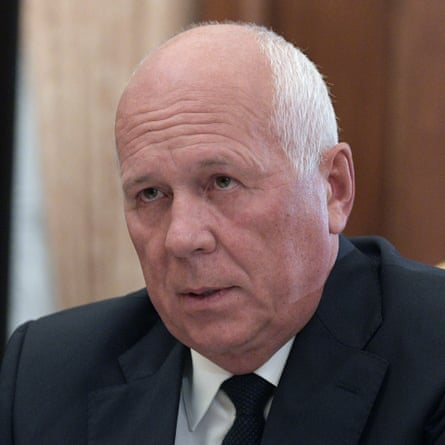
A former KGB officer who befriended Vladimir Putin in the 1980s while living in the same apartment building, Sergey Chemezov rose through Russia’s public and private sector in Putin’s wake, and in 2007 was appointed as CEO of Russia’s state-owned defense giant Rostec, a position he still holds today. Chemezov was sanctioned by the US in 2014 amid Rostec’s role as a supplier for Russia’s invasion of Crimea, and Washington is targeting him again, now with his family members.
According to investigative reports and allegations from the jailed activist Alexei Navalny, Chemezov’s relatives have used shell companies to accumulate eye-watering assets , including superyachts and luxury villas around the world. But Chemezov says he’s clean, telling Russian media in 2019: “I do not accumulate wealth. I don’t stuff money in the corners. I don’t have yachts or airplanes.”
Nikolai Tokarev
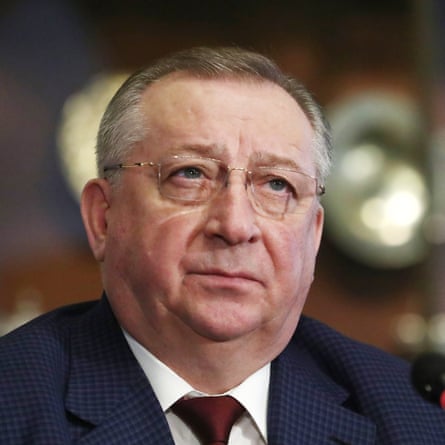
Another former KGB officer who served alongside Putin and Chemezov, Nikolai Tokarev took over former Soviet state assets as Putin built his political power, and in 2007 became the head of the state-controlled oil giant Transneft. The oligarch has used his position at Transneft to build a business and real estate empire, which reportedly includes sponsoring an extremely fancy palace that’s said to be personally used by Putin. Tokarev was hit by US and EU sanctions this week.

Vladimir Potanin
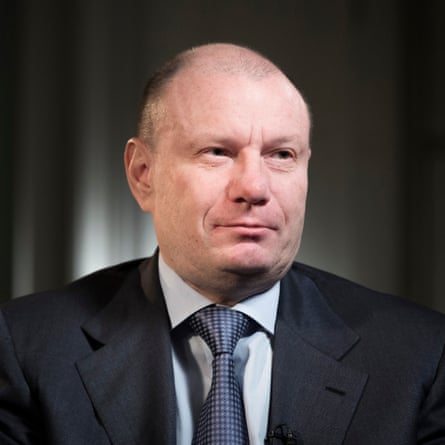
Reportedly the second richest man in Russia, the banker, metals mining tycoon and former deputy prime minister Vladimir Potanin was among a small circle of oligarchs who met with Putin last week as the invasion of Ukraine began.
Potanin has played a big role in American arts: he has been a board member of New York’s Guggenheim Museum for two decades, until he stepped down on Wednesday. He has also given millions to the Kennedy Center in Washington, which carved his name into a wall. He is also known to have owned property in New York City , which came to light during a divorce fight that could cost him $7bn.
Potanin isn’t currently under US sanctions, which is good news for his three megayachts and two private jets (that we know about).
Leonid Mikhelson

Russia’s richest man in 2016, Leonid Mikhelson is the founder and chairman of natural gas producer Novatek, a close friend of Putin’s, and a business partner of Gennady Timchenko, a billionaire who has been under US sanctions since 2014.
Mikhelson loves art: along with his $200m art collection, he was on the board of trustees at New York’s New Museum from 2013 to 2017, and has sponsored exhibitions at the Art Institute of Chicago and London’s Tate Modern. His ostentatious superyacht, the Pacific, can reportedly accommodate two helicopters.
But his other assets may be harder to trace. In 2017, the Panama Papers revealed that Mikhelson had used an intricate system of shell companies to secretly register a $65m Gulfstream private jet in the United States, which in most cases requires US citizenship or permanent residency.
The tycoon is not currently subject to sanctions, though his company Novatek is.
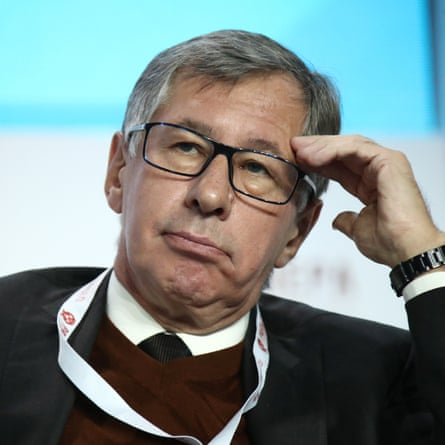
Petr Aven is the head of Alfa Group, a commercial bank subject to US sanctions that helped him amass an estimated $5.5bn fortune. A well-known collector of classical Russian paintings, Aven has lent works from his collection – reportedly worth $200m – to New York’s Museum of Modern Art and the Neue Galerie. Aven reportedly has never bought a plane or yacht, and told the FT “all my money goes in to art.” That is, of course, if you don’t count the millions he spent transforming an 8.5-acre plot in England into a “KGB-proof” mansion , complete with a bomb-proof panic room.
Last year, Aven filed a libel lawsuit against HarperCollins for a book it published about Vladimir Putin’s rise, Putin’s People.
Aven was sanctioned on Monday by the EU, which described him as “one of Vladimir Putin’s closest oligarchs” and one of “approximately 50 wealthy Russian businessmen who regularly meet with Vladimir Putin in the Kremlin”. He has not yet been placed under sanctions by the US or UK.
Mikhail Fridman

Petr Aven’s business partner, Mikhail Fridman, is Alfa Group’s founder and a Ukrainian-born Russian oligarch. Fridman has made substantial investments in the United States, which include spending a reported $1bn in 2011 to buy up distressed properties across the east coast, telling the Wall Street Journal at the time, “The American market is the most well-regulated and liquid market in the world. It has the best protection for investor rights.”
Through Fridman’s investment group, LetterOne, the billionaire also sank $200m into Uber , and $50m into the telecom startup FreedomPop. Fridman also caused a stir in 2018 when he spoke alongside Aven at a closed-door dinner hosted by the Atlantic Council, a major US foreign policy thinktank, in what critics saw as an unofficial Kremlin mission to protest against US sanctions.
Last week, Fridman became one of the first oligarchs to speak out against the invasion of Ukraine, calling it a “tragedy” and writing that “war can never be the answer.” Nonetheless, Fridman was subjected to sanctions on Monday by the EU, which named him as “a top Russian financier and enabler of Putin’s inner circle”. Like Aven, he has not yet been placed under sanctions by the US or UK.
The oligarch has a son, Alexander, who is reportedly attending NYU’s Stern business school, after a stint in Moscow selling hookah .
Alexei Mordashov

Currently Russia’s richest man, Alexei Mordashov owns a third of Tui, Europe’s biggest tourism firm, and gained his billions as the chief executive of Russia’s largest steel and mining firm, Severstal. He is also a large shareholder of the Bank of Rossiya, which has opened up branches across Russia-occupied Ukrainian territory in recent years.
Over the last two decades, the billionaire has also poured money into the United States, investing heavily through Severstal in steel companies in the midwest before selling them for $2.3bn in 2014.
Mordashov has been hit with sanctions by the EU, but the US hasn’t taken action yet. They would be interested in his Bombardier Global 6000 private jet and multiple superyachts, including the $500m Nord, which Senator Bernie Sanders noted on Tuesday had been “sailing in the Seychelles region for more than 10 days” in a Twitter thread about Russian offshore wealth.
Roman Abramovich
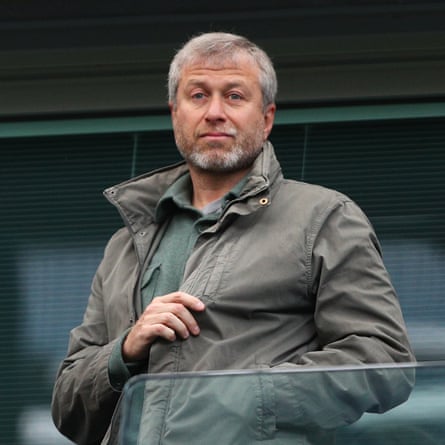
Roman Abramovich, the longtime owner of Chelsea FC, has been described by a member of the UK parliament as a “ key enabler ” of Putin’s regime, which Abramovich has long denied. An orphan raised by his grandparents in Siberia, Abramovich pulled himself up by his bootstraps the old-fashioned way: wriggling into the inner circles of government and then profiting hugely by selling previously state-owned assets that he acquired after the fall of the Soviet Union.
The billionaire owns one of the world’s most outlandish yachts, complete with an onboard submarine and three helicopters. He has also owned a number of ultra-expensive properties in the United States, including a trio of buildings in New York City’s Upper East Side worth more than $90m combined, which he transferred to his third wife, Darya Zhukova, in 2018.
Abramovich is not currently under western sanctions. Earlier, the British prime minister, Boris Johnson, told the House of Commons that Abramovich was “already facing sanctions” though later said he “misspoke”.
This article was amended on 7 March 2022 to clarify that Leonid Mikhelson was on the New Museum’s board from from 2013 to 2017
Most viewed
- Bahasa Indonesia
- Slovenščina
- Science & Tech
- Russian Kitchen
Why is Moscow called ‘the port of five seas’?
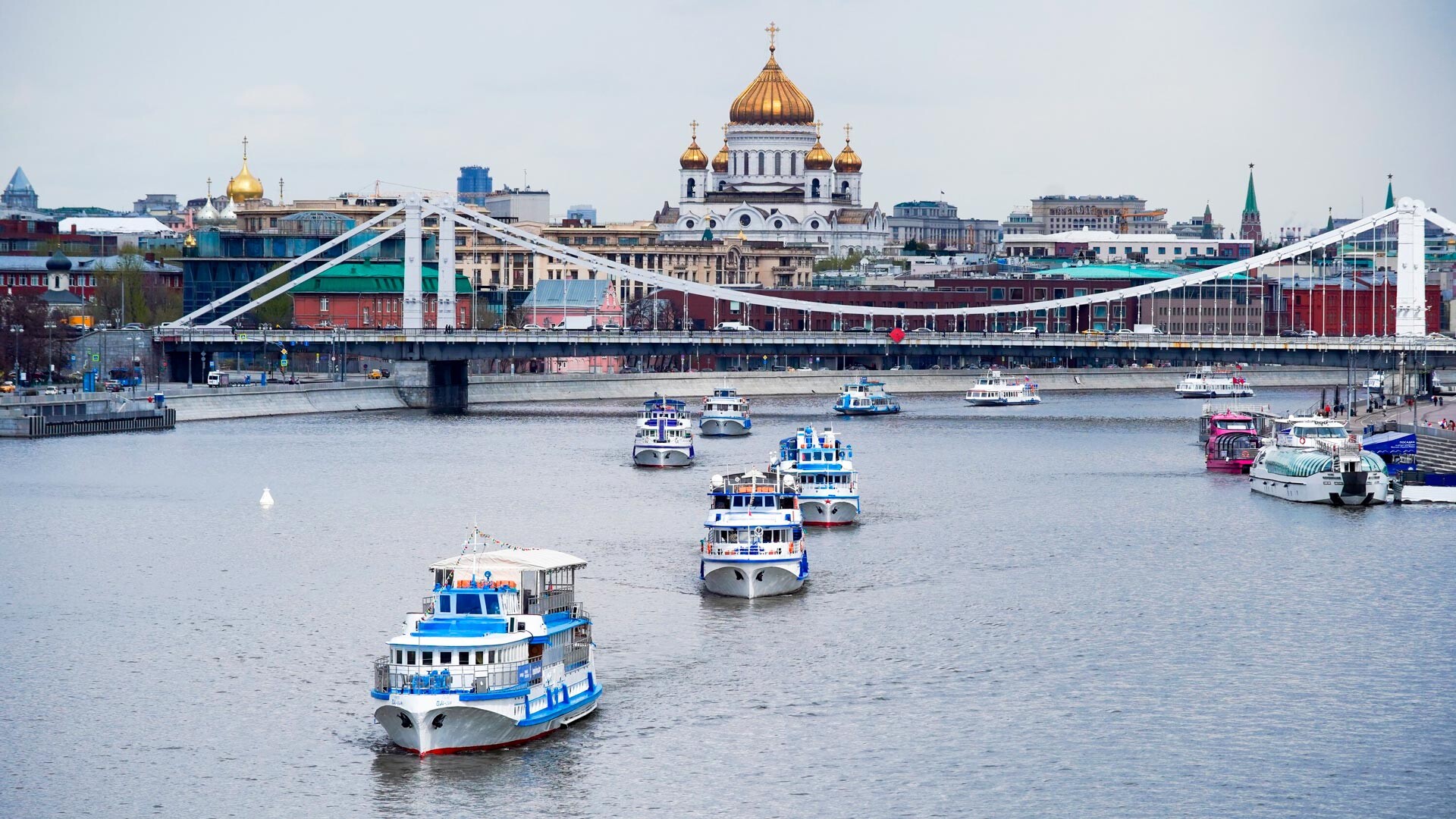
Moscow has many nicknames : ‘A City on Seven Hills’; ‘The Third Rome’; ‘White-Stoned’; and most surprisingly, ‘The Port of the Five Seas’. Geography, however, won’t help in explaining how this is possible. If you look on a map, you’ll see that Moscow’s location is not even close to any sea. The nearest is the Gulf of Finland (which flows into the Baltic Sea) and where St. Petersburg is located. But that’s about 600 kilometers from Moscow.
How did this nickname originate?
As usual the answer lies in history, though not so distant in the past. The first to call Moscow ‘a port of five seas’ was Joseph Stalin, and the matter was connected with the country’s rapid industrialisation.
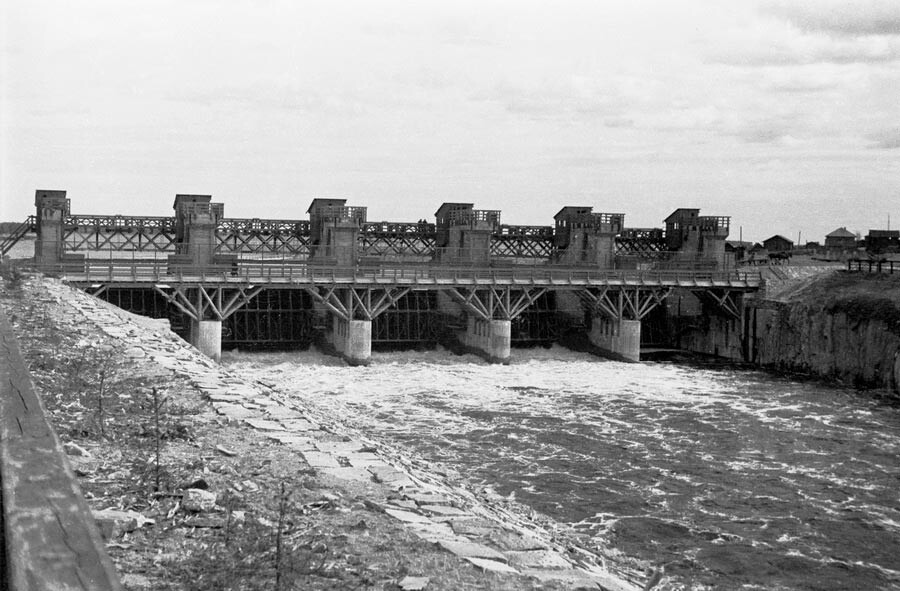
The White Sea-Baltic Canal, 1933
Huge ‘communist constructions’ were arranged throughout the Soviet Union. The most ambitious were canals. The most infamous project was the White Sea-Baltic Canal built by prisoners in record time, costing the lives of thousands of prisoners.
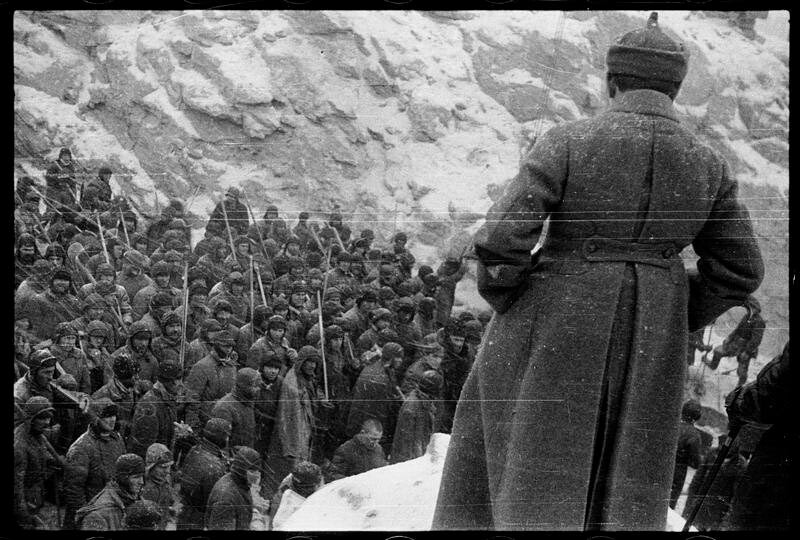
Prisoners on the construction of the White Sea-Baltic Canal
At the same time, Stalin arranged a huge plan for rebuilding Moscow. The city had to be modernized to be a suitable and impressive capital for the new ambitious and progressive Soviet nation. Moscow in the late 1920s, however, still looked quite provincial. For several centuries during the Imperial era it had become a second-rate city, since most development and progress was focused in the Tsar’s capital St. Petersburg.
Stalin began construction on a metro system, built new thoroughfares and highways, and even made the streets broader (in some cases even the buildings were moved !). Without any hesitation Stalin ordered to get rid of anything that could interrupt a new highway or prospect.
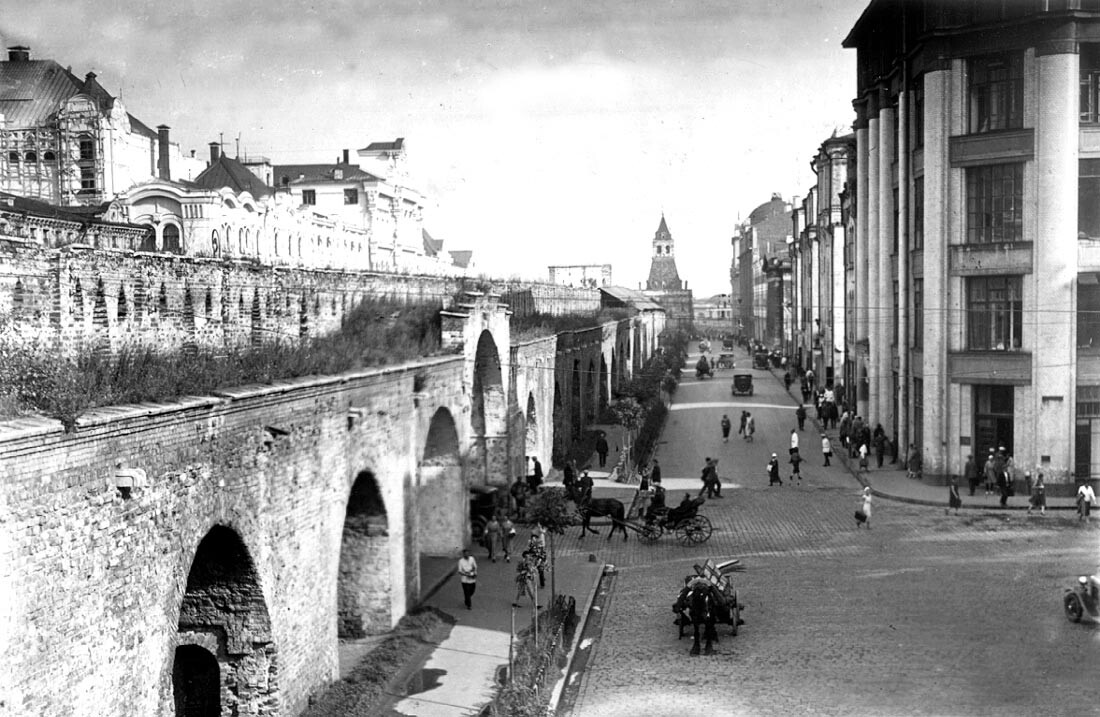
Moscow's Kitay-Gorod wall and gates, 1920s
Many structures connected to the old regime were demolished, including dozens of old churches and monasteries, as well as the Kitay-Gorod Wall, a 16th century fortification in the city center, just one kilometer from the Kremlin.
To supply a rapidly developing Moscow with a large amount of drinking and industrial water, and to make it accessible to shipping, Stalin ordered the building of a canal that connected the relatively small Moskva River with the Volga River. (Peter the Great first thought of this ambitious idea back in the 18th century, but never realized it).
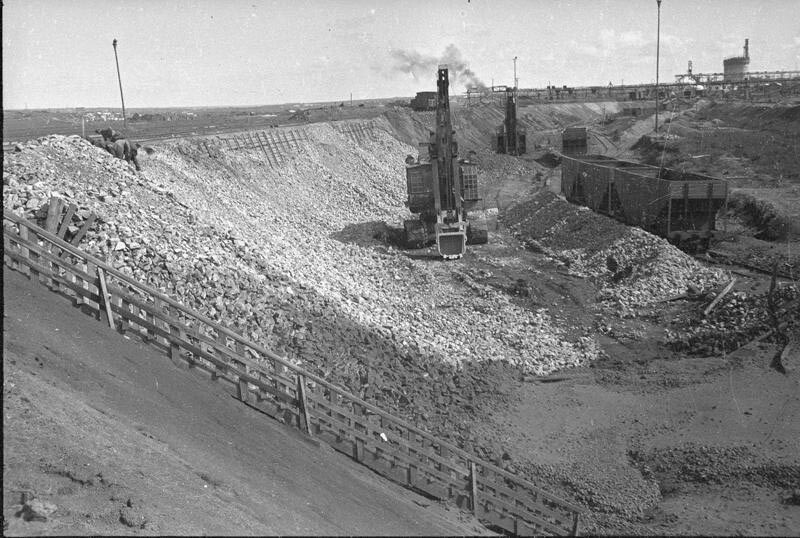
The construction of the Moskva-Volga Canal, 1934-1937
The 128 kilometers waterway was built by Gulag prisoners from 1932 to 1937. First it was called the ‘Moskva-Volga canal’, but in 1947 it was renamed the ‘Moscow Canal’. The famous phrase – Moscow is now ‘a port of five seas’ – was pronounced by Stalin in 1937 at the canal opening ceremony.
Which seas does it connect with?
The White Sea and the Baltic Sea were connected by a canal, and the Baltic Sea was connected with the Volga River by a system of canals and rivers. The building of Moskva-Volga canal made it possible to reach the White Sea and the Baltic Sea by sailing from Moscow.
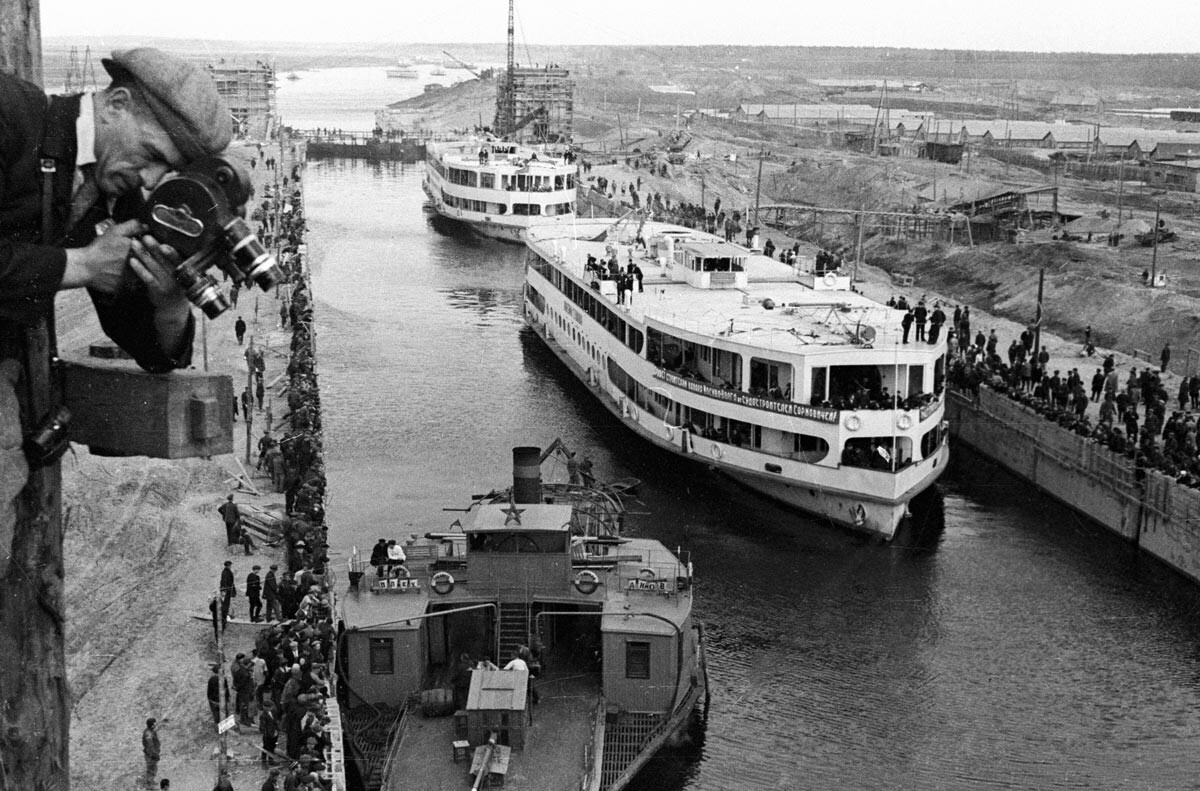
First ship enters lock on the Moscow-Volga Canal
The third sea is the Caspian, into which the Volga flows. Later, in the 1950s, another huge canal appeared - a 101 km waterway between the Volga and the Don rivers was built in Volgograd. This canal gave access from the Volga to the Sea of Azov - and subsequently to the Black Sea.
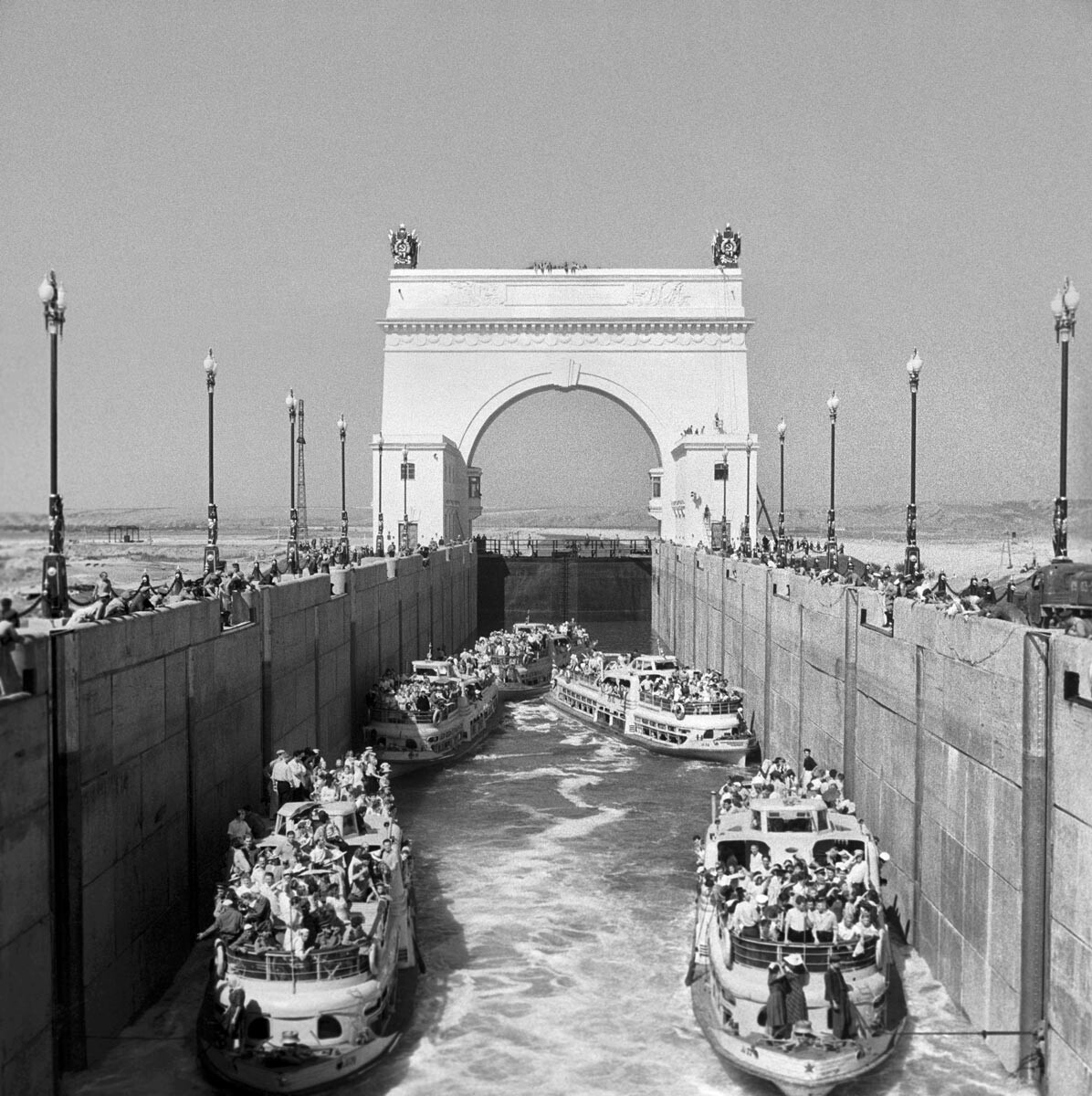
The Volga-Don Canal, 1952
After all those big Soviet construction projects were completed, it was possible to reach the five seas without ever leaving one’s ship: the White, Baltic, Caspian and Black Sea, as well as the Sea of Azov.
Now what do you think – is Moscow a sea port or not?
Dear readers,
Our website and social media accounts are under threat of being restricted or banned, due to the current circumstances. So, to keep up with our latest content, simply do the following:
- Subscribe to our Telegram channel
- Subscribe to our weekly email newsletter
- Enable push notifications on our website
- Install a VPN service on your computer and/or phone to have access to our website, even if it is blocked in your country
If using any of Russia Beyond's content, partly or in full, always provide an active hyperlink to the original material.
to our newsletter!
Get the week's best stories straight to your inbox
- 10 most popular nicknames for Moscow
- 5 movies to help you better understand Russian history
- Why are there so many lions in St. Petersburg? (PHOTOS)
This website uses cookies. Click here to find out more.
AirBaltic CEO says it could make sense to join larger group eventually
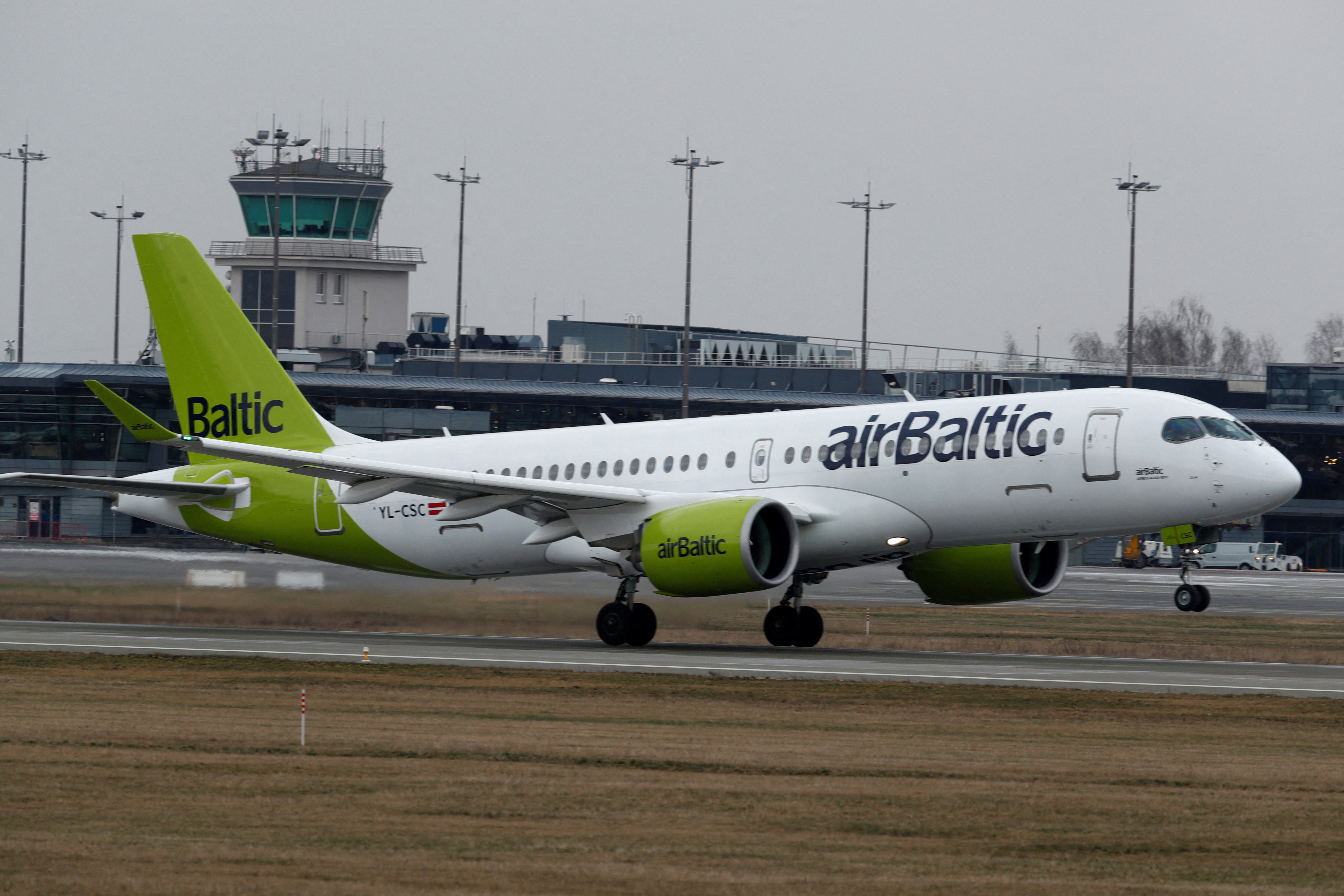
Get U.S. personal finance tips and insight straight to your inbox with the Reuters On the Money newsletter. Sign up here.
Reporting by Joanna Plucinska Editing by Mark Potter
Our Standards: The Thomson Reuters Trust Principles. , opens new tab

Thomson Reuters
Joanna reports on airlines and travel in Europe, including tourism trends, sustainability and policy. She was previously based in Warsaw, where she covered politics and general news. She wrote stories on everything from Chinese spies to migrants stranded in forests along the Belarusian border. In 2022, she spent six weeks covering the war in Ukraine, with a focus on the evacuation of children, war reparations and evidence that Russian commanders knew of sexual violence by their troops. Joanna graduated from the Columbia Journalism School in 2014. Before joining Reuters, she worked in Hong Kong for TIME and later in Brussels reporting on EU tech policy for POLITICO Europe.
Shares of Astera Labs jumped as much as 55% on their Nasdaq debut on Wednesday, giving the chip firm a market capitalization of $8.52 billion, as it tapped into the investor enthusiasm for artificial intelligence.

Wall St holds ground ahead of Fed decision
Wall Street's main stock indexes were little changed on Wednesday as investors awaited the conclusion of the Federal Reserve's meeting where it is expected to keep interest rates unchanged and provide cues on its monetary policy trajectory.

- About our Authors
- SRAS: Study Abroad or Online
- Folkways: Folk Culture
- PopKult: Popular Culture
- Students Abroad: Travel Guides
- Museum Studies Abroad: High Culture and City Planning

Origins of Russia: Moscow Becomes an Empire (Prehistory to 1584)

12 April 2023
Moscow is not just a city. It was a fort that became a city, that became a state, that became an empire, that became a superpower. Moscow maintained an unlikely meteoric rise to the global stage that continued steadily over the course of several centuries. Modern Russia can be understood as a product of this unique development: as a country that was rapidly assembled, piece by piece, from the epicenter of its capital by the will, luck, and political maneuverings of rulers that have been historically based in that city.
Geohistory: the Foundations of Moscow and the Russian State
Moscow was officially founded in 1147 by Yuri Dolgoruki, the Grand Prince of Kyiv. The name “Moscow,” applied to both the new garrison and the adjacent river, may have come from the Slavic, Baltic, or even Uralic or Finno-Urgic peoples who lived in or traveled through the land for centuries before.
While there is debate on the origin, there is little debate on the meaning of the name; in all four cases, the name refers to swampland, as this is what much of the region originally was.
Moscow lies near the center of Earth’s largest, flattest expanse of territory. With no natural defenses to slow down invaders, Moscow developed a policy of continually expanding its boarders, conquering and absorbing potential adversaries and placing more distance between the Russian heartland and those adversaries.
In 1147, Moscow was a small fishing village inhabited by Slavic peoples who had begun draining the surrounding swamps in the previous century. Moscow was founded at a time when Yuri’s powerful Kyivan principality was expanding northward, colonizing and consolidating lands stretching towards the Arctic. Moscow’s location gave the principality another access point to the Volga River system, which provided transport to the principality’s new northward lands and provided increased opportunities to expand further east on the Volga which was then already part of economically valuable trade routes between Europe and Asia.
Although the location had value to Kyiv at the time, there was little reason to believe that the new garrison would one day become the geopolitical center of a vast swath of the Earth. The Moscow River is a relatively small offshoot in the Volga system. Moscow’s placement provides an access point to, but not strategic control over any part of that system. Further, unlike most major European capitals, Moscow had no direct ocean access for wider, more valuable international trade and communication. The weather there is wet and the soil soft and moist, creating challenges for growing crops, storing food, and constructing infrastructure. The surrounding swampland bred mosquitos, which spread disease. A lack of accessible quarries meant that Moscow was long dependent on wooden architecture and, thus, susceptible to fires. Beyond Moscow, the vast expanses of Eurasia that it would one day control lay mostly flat for hundreds of miles in any direction. There was nothing to stop the numerous invading armies that would constantly challenge it. In fact, Moscow’s best natural defense was the bad weather and boggy soil that made inhabiting it a challenge in the first place.
Moscow, perhaps more than any other city on Earth, is a testament to the fact that while geography often gives advantages or disadvantages, sometimes the force of history and the will of man can rival even the power of nature. Moscow grew from the personal ambitions of its rulers, ambitions that were given an immediacy and perceived necessity by the challenges that those ambitions faced.
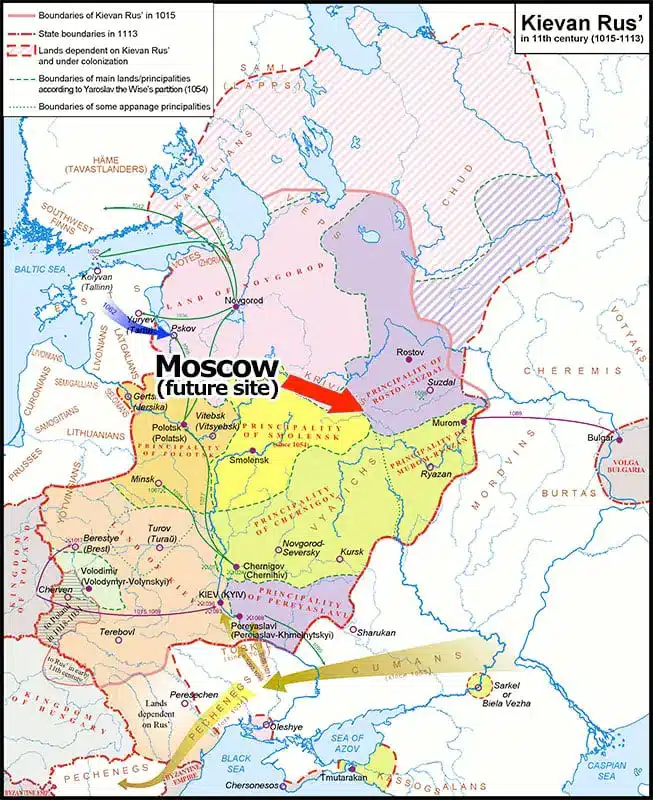
Kyiven Rus, a few years before Moscow was founded. Moscow’s future site, on a relatively minor river, has been added with a red arrow. The shaded area at the north was under colonization by Kyiv at the time. For the original, larger map, click the photo.
The Early Development of Moscow
Ten years after Moscow’s official founding, a wooden wall was built to protect it, forming the original Kremlin. At about the same time, Kyiv proclaimed the Vladimir-Suzdal Principality to further consolidate its governance of the area. Moscow was then a minor outpost near the border of that principality.
Development was slow and, when the Mongols invaded in the first half of the 13th century, Moscow was one of several cities burned to the ground. In the 1260s, Moscow was inherited by Daniel, Alexander Nevsky’s two-year-old son. By tradition, the youngest son inherited his father’s least valuable possessions.
By his teens, Daniel proved to be an adept ruler who made the most of the chaotic times that surrounded him. With Mongol rule established and with the death of Nevsky, who had been a strong and popular ruler, the area fractured into competing forces. The Mongols also effectively cut the principality from Kyiv, whose empire would collapse by the end of the century. Mongol rule would greatly affect the development of the Russian language, culture, and political systems .
By shifting his alliances between his extended family members and by keeping Moscow away from most direct conflicts, Daniel maintained influence in the region’s larger and more powerful cities, particularly the rising capital of Vladimir. By 1296, his influence was such that the Prince of Ryazan, considering Daniel a potential future adversary and likely an easy, youthful target, attempted to conquer Moscow with the help of allied Mongol forces.
Daniel, however, decisively defeated the invasion and even secured from Ryazan control of the Moscow River when Ryazan sued for peace. With control of the river, Moscow’s economy grew at an expedited pace. Daniel’s victory was one of the first achieved by the Russians over the Mongols and would become part of the narrative of a rising Russian nationalism. It was also the only major military battle that Daniel ever led (he otherwise fought under his more powerful brothers).
Shortly before Daniel’s death, his childless nephew and ally, Ivan of Pereslavl, bequeathed to Daniel all his lands, including Pereslavl, the former residence of Alexander Nevsksy that had served as a second capital under Nevsky’s grand rule. The acquisition increased Moscow’s wealth and political power.
By the time that Daniel died in 1303, Moscow had grown into a relatively small regional power of note with expanding political and territorial influence, economic potential, and cultural value as the pious Daniel had founded the city’s first monasteries and major churches, including the Danilov Monastery, which still exists and now bears his name.
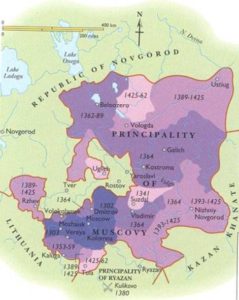
The expansion of Moscow Principality from Daniel (darkest purple in the south) ca. 1300 to Vasily II (light pink) in 1462. Note the surrounding rivals: the Mongols, Ryazan, Lithuania, and Novgorod. For a larger version, click the map.
Yuri, Daniel’s eldest son, inherited his crown. Yuri’s rule was much more aggressive – taking new lands to the West and North of Moscow from the Prince of Smolensk and the Swedes to secure access to the Neva River system. That system flows to the Baltic Sea, the closest point of direct ocean access available to Moscow. Yuri would gain only indirect access, however; Moscow’s ships still had to pass through the lands of other powers to actually reach the sea. Moscow would spend centuries trying to gain a direct foothold on the Baltic and uncontested ocean access.
Yuri aggressively sought political influence with the Mongols, which were then solidly in power and thus the most direct way to secure his inheritance from his increasingly covetous rivals.
Moscow’s lasting influence was solidified under Yuri’s son, Ivan. Ivan successfully petitioned the Mongols for the title of Grand Prince, giving him the ability to collect taxes from all Russian lands and making him the single point of contact to pay the tribute demanded by the Mongols from those diverse and fractured lands. Ivan used his new source of finances to build infrastructure, buy land, and offer loans to surrounding principalities (and often annexing them when payments fell behind). He even bought more Russians to populate his lands (from the Mongols who had captured them elsewhere). As Moscow grew, and was comparatively safe from Mongol raids (due to its pledged Mongol loyalty and geographic buffers), more people from surrounding areas moved to live under the protection and growing prosperity of Ivan. In 1325, the Metropolitan of the Russian Orthodox Church moved the seat of his See from Vladimir to Moscow.
Thus, over the course of just three generations, Moscow skyrocketed from being the region’s least-valuable garrison to effectively competing with the other regional powers around it – including Tver, Ryazan, Novgorod, and even Vladimir, the official capital. Moscow took full advantage of the political situation caused by the Mongol invasions and built wealth and power by acquiring control of additional lands, full control of the Moscow River, and involving itself directly in the Mongol-imposed governance structures. Moscow’s wealth and power, although still small and very much confined to its region, were growing.
Moscow still faced all the same challenges, however. It lacked ocean access, it ruled flat, indefensible terrain in a challenging climate, and was surrounded by potential adversaries. Many of those rivals, particularly Novgorod and Ryazan, were comparatively quite powerful, to say nothing of the threat Moscow might face from the Mongol overlords should it fall from favor.
Cracks in Mongol Rule
The Mongols continued to favor and strengthen Moscow, however. They did so particularly as a line of defense against the growing power of the Lithuanians to the West. The Mongols were long Moscow’s greatest asset; eventually, Moscow became a major liability for the Mongols. Moscow became strong enough to dominate the surrounding lands and defend against encroachments, and, later, strong enough challenge the Mongols themselves.
This began in 1362, when then-Prince of Moscow Dimitri Donskoi sought approval from the Mongols for a formal takeover of Vladimir, the former regional capital. Mamai, then leading the Mongols, denied the takeover, perhaps trying to taper Moscow’s growing power, and awarded the city instead to the rulers of Tver, a rival of Moscow.
By 1375, Donskoi negotiated with Mikhail II of Tver (whose chief benefactor had been the now-defeated Lithuanians) to take possession of Vladimir. However, the Mongols still refused to recognize the transfer. Donskoi, who knew that the Mongols at that time were weakened by internal divisions, and having pacified the Lithuanians by withstanding their sieges, mounted a military challenge against the Mongols that would transform the surrounding political landscape.
Initially defeated in his 1377 offensive, Donskoi defended successfully against the 1378 Mongol counterattack. Both sides doubled down and prepared for a great battle. Mamai concluded an agreement with Lithuania, his archrival, to join forces and defeat Moscow. Many Russian princes that had sworn allegiance to the Mongols, including Mikhail II of Tver, rebelled and joined Moscow. Several Russian princes that had allied previously with Lithuania against the Mongols broke their Lithuanian ties and joined Moscow. The Principality of Ryazan split, with the Prince there pledging a large armed force to the Mongol side, but with many of his boyers, in fact, defecting to Moscow. The leader of the Russian Orthodox Church officially gave his blessing to Donskoi and contributed a contingent of warrior monks.
In 1380, Donskoi managed to attack the Mongols before reinforcements could arrive from either Lithuania or Ryazan. Donskoi, despite being outnumbered nearly 2-1, defeated the Mongols. The Lithuanians recalled their troops en route and Ryazan was forced to bow to Moscow. Although a massive Mongol army sent from Central Asia would burn Moscow and regain control of the city in 1382, Donskoi, by the end of his reign in 1389, had made Moscow a symbol of Russian resistance and a center for Russian nationalism. He had also, despite eventually losing to the Mongols, more than doubled the size of the lands under Moscow’s control and, in fact, now claimed the right from the Mongols to hand down the title of Grand Prince (with its functions of general tax collecting) to his heirs without first consulting the Khan. This ensured that Moscow’s greatest asset was now under its own control.
Vasili the II saw the most troubled reign of any Moscovite prince to date. A civil war saw him imprisoned and blinded. However, he still expanded his territory and the power of the Moscow throne by the end of his time in power.
Origins of the Muscovite Civil War
Although Moscow was now a sizeable and wealthy state, after Donskoi’s reign, many of the advantages that had contributed to its meteoric rise were lost: freedom from Mongol invasions and a series of uncontested successions. However, even the loss of these advantages did not stop Moscow’s rapid expansion.
In 1392, under Vasily I, Donskoi’s son, Moscow annexed Nizhny Novgorod, another former rival. In 1395, Vasily claimed the infighting within the Mongol empire prevented him from transferring his tribute: he did not know to whom to send it. He kept collecting taxes as the Grand Prince, but put the full force of these finances into his own kingdom – rapidly expanding north and east – taking Suzdal, Vologda, and conquering the Komi peoples. By 1408, the horde regrouped and retaliated, burning several cities including Moscow to reinstate their authority. By 1414, Vasily was again a vassal of the horde, but now a much larger and more powerful vassal, and resumed paying tribute.
Vasily II, eldest son of Vasily I, assumed the throne in 1425. However, the former ruler’s brother, Yuri, claiming that he was the oldest eligible male heir, received permission from the Mongols to take Moscow by force. The Mongol leader may have hoped to have a new prince that would be more indebted to him and less likely to rebel. The Mongols may have calculated as well that the move would spark a civil war, one that might pull Moscow’s valuable surrounding duchy apart, giving Moscow’s ruler fewer resources and thus making him more manageable. In any case, in the midst of the 28-year Muscovite Civil War that followed, the Khanate of Kazan was established and the new leader there, to establish his supremacy over Moscow, also attacked while the city was weakened.
Vasily II was defeated several times, taken prisoner, and even blinded by his enemies. However, those enemies always left him alive, perhaps fearing retribution from his numerous supporters. Each time he regained his freedom, he regrouped and attacked again.
At the end of the war, Vasily remained much as he had begun: with his crown and lands and as a Mongol vassal. Given the circumstances, this was itself an incredible feat. Further, Vasily would also still have time to significantly expand Moscow’s power and influence by the end of his reign.
In 1453 (the year the Muscovite Civil War ended), Constantinople, then the center of Eastern Orthodoxy, was taken by the Turks. The Orthodox Patriarch there ceded his primacy to the Pope of Rome. Moscow, like many Orthodox centers, refused to recognize the new hierarchy, which would have brought all of Christianity under a single leadership for the first time since the fall of Rome.
Vasily II nominated a new Metropolitan, Jonah, to take over religious leadership of the lands of Rus. Jonah was elected by the bishops of Moscow – the first such election without the oversight of Constantinople. Although controversial, this advanced Russian nationalism and secured Moscow’s place as a center for that nationalism. This would be a valuable tool against Mongol rule.
Ivan III – Consolidation of the State
Until Ivan III, son of Vasily II, the Grand Duchy of Moscow had been a complicated amalgamation of lands, many of them semi-autonomous, but all united in various ways and to various degrees under Moscow. Ivan would change this.
Lands added to the Moscow Principality under Ivan III after 1462 are shown in green. This includes the very large Novgorod Republic (the solid green section at the top). Its most valuable lands were in the Arctic, and were rich in furs. For a larger version, click the map.
Ivan III was born in the midst of the civil war; it ended when he was 13. His next nine years were spent taking care of his blind father and increasingly shouldering the work of running the duchy. By the time he inherited the throne in 1462, at the age of 22, he was an experienced leader and was convinced that only strong, centralized leadership would hold his state together. He was also heir to the already well-established Russian belief that the only way to make sure the borders of the state were secure, in the face of numerous adversaries, was to continually grow them at the expense of those adversaries.
Ivan began by confronting Novgorod, a Slavic republic that drew considerable wealth by harvesting furs in the vast swaths of Arctic lands that it controlled. The Mongols required Moscow to gather tribute from Novgorod although the Mongols had never actually sacked that city (probably due to the severe boglands surrounding it). Novgorod had, like Moscow, often maneuvered for more independence, but from Moscow, not the Mongols.
The split between Moscow and Novgorod ran deep. Novgorod’s highly institutionalized and decentralized system of government in which princes served at the invitation of the people stood in stark contrast to Moscow’s centralized and personalized ruling traditions. In fact, Novgorod’s social systems were much closer to what had developed in the Polish-Lithuanian Commonwealth during its golden age. Novgorod had constant contact with the Poles, a fellow Slavic people, in maintaining their trade routes to Europe.
As Novgorod saw Moscow annexing more Slavic lands while the Mongol empire crumbled, Novgorod sought to protect its interests by making a pact with Poland. However, under a treaty that Novgorod had signed with Moscow, all Novgorod’s actions in the realm of foreign affairs were to be approved by Moscow first. Such approval had not been sought or given. Further, the Poles held an alliance with the Mongols at that time and Ivan saw Novgorod’s alliances as truly enveloping Moscow in united rivals. Ivan moved to enforce the treaty by invading.
Ivan defeated Novgorod, confiscated its most valuable lands, and demanded a treaty giving Moscow even more authority. Ivan’s subsequent attempts to stamp out opposition in Novgorod by diplomacy and, increasingly, arrests and violence proved unsuccessful. Seven years after the first invasion, Ivan invaded again, slaughtering the population, burning parts of Novgorod, and demanding, and receiving, the complete political subjugation of the city in 1478. The city’s population, however, would continue to be restless against Moscow rule for at least the next two generations.
A map showing the full expansion of the Russian Empire. Areas marked in blue were under Russian control at the end of the reign of Ivan III. Ivan IV added the vast majority of what is marked in purple. Note that the area marked in blue around the Baltic Sea was not secure enough nor held for long enough intervals to be developed as economically or militarily viable territory until after 1721. For a larger version, click here .
The fall of Novgorod was important for many reasons. It represented the most significant expansion of Moscow’s borders to date, an expansion that would only continue to escalate in the coming years. It also represented the fall of what was the most significant ethnically Russian rival to Moscow. Thus, this marked the beginning of Ivan’s long campaign to consolidate his holdings under his direct authority while making Moscow the most powerful political base of Russian nationalism.
Ivan went so far as to declare war on his brothers to ensure that their land was completely controlled by him. Boyars were effectively reduced to civil servants, carrying out Ivan’s will. To make sure that this could be done effectively, Ivan had the Sudebnik, Russia’s first code of laws, drawn up. The Sudebnik was largely concerned with regulating land ownership and facilitated continued takeovers by Ivan. It also, however, provided a unified system of justice, codified rights and obligations for all classes, and allowed for serfs to change masters under certain conditions if they wished.
Ivan refused to pay the customary Mongol tribute in 1476, marking yet another attempt by Moscow to declare independence. When the Mongols arrived in 1480 with a large force of horse mounted archers and spear-carrying warriors, Ivan met them with a smaller force equipped with newly acquired firearms and cannons. The Mongols retreated and, before they could launch a new offensive, the Golden Horde, long fractured and struggling, collapsed. The various Mongol states that emerged from that fall would still pose challenges for Moscow, but never again would Moscow face a united Mongol front or again pay tribute to the Mongols.
After the breakup of the Polish-Lithuanian Commonwealth, Ivan pushed West, into former commonwealth lands, as far as possible. Ivan hoped to gain direct access to the Baltic and also to realize what he saw as a rightful claim to Kyiv. Considerable advances towards these goals were made, including establishing a fort on the Narva just a few kilometers from the Baltic Sea and deep advances south towards Kyiv, but these were soon lost again as his rivals regrouped and counter attacked.
Despite this, by the end of his reign, Ivan III had tripled the size of his lands and consolidated his rule into what was shaping into a massive consolidated monarchy. Ivan’s son, Vasilli II, continued his policies, further consolidating and expanding, mostly at the expense of the Lithuanians and the Poles.
Ivan IV – The First Tsar
Ivan IV, who would be known as Ivan the Terrible, led the most dramatic and violent rule of any Moscow leader before him starting in 1533. This would be largely driven by ambition but also by his proclivity to mental illness and fits of rage coupled with an intensification of many challenges that Russia had traditionally faced. In general, however, his rule can be seen as a continuation of what came before and as driven by the geographic constraints of his land and by the historical memory handed down to him by past leaders.
Ivan had himself crowned “Tsar of All Russia” in 1547 when he was just 16, pushing for a leadership role molded off Caesar of Rome – absolute and answerable only to God. He created the Zemsky Sobor, a legislative organ that included boyers, clergy, and local leaders. He expanded the rights of local governments at the expense of the aristocracy and solidified the rights of serfs to leave their masters under certain conditions. He reformed the Russian church by posing 100 questions to church leaders and calling them to a conference to have them answered. Although he experimented with somewhat more inclusive forms of governance, Ivan also founded the Oprichniki – a group of individuals who were granted land in return for acting as secret police – seeking out and eliminating any threat to Ivan’s rule.
Ivan’s attempts to push his borders to the Baltic Sea soon saw him fighting the Swedes, Latvians, German Hanseatic League, and the Poles. Now, instead of having passive access to the sea through the Neva, he faced a full Swedish blockade. The wars were enormously expensive, and the economic devastation was compounded by droughts and plagues. War, famine, and disease drained the Russian countryside of the agricultural workforce that created the vast majority of the country’s economic value, putting great strain on Ivan’s rule.
Rebuffed in the west, Ivan was much more successful in the east. Ivan subjugated Kazan and Astrakhan, two bordering Mongol territories, and thus gained strategic control over the economically valuable Volga and Komi Rivers. Ivan issued a patent to the powerful Strogonov family to develop the newly acquired Siberian lands. The Strogonovs hired Cossacks as a private army to protect their possessions, and sent the Cossacks deeper into Siberia, again, to secure the borders by expanding them.
Although the Strongonovs planned to proclaim themselves the rulers over the Cossack gains, the Cossacks pledged loyalty directly to Ivan in return for reinforcements to continue the drive east, eventually giving Ivan control over most of another river system, the Ob-Irtysh in Siberia.
Moscow as an Empire: More Land with the Same Problems
A detail of a land use map for the USSR, ca. 1960, centered on the area under Russian control in 1584. Note that even in 1960, about half of this land was undeveloped. Solid green areas (heavily forested), stripped green (swampland), yellow (desert), and stripped white (arctic tundra) are largely depopulated and were used for hunting, trapping, and nomadic herding, if at all. The area around Moscow was mixed use (farming, grazing, and forestry). Red, orange, and purple areas were used relatively intensively for agriculture to support larger populations but were, overall, poorly irrigated and faced transport issues to move the food to population centers. Russia would always struggle with poor land quality and inefficient land use. For a larger version, click the map.
By the end of his reign, Ivan had further consolidated Moscow’s control over a massive and growing swath of land that stretched from the Caspian to the Arctic. However, even now, Moscow’s empire still faced the same basic challenges it had when it was the region’s least valuable fort.
Moscow still had no ocean access and thus no access to the valuable trade and communication capabilities that that represented. Further, despite its size, Moscow was still surrounded by a flat landscape with almost no significant geographic defenses. The Urals perhaps represented the best such asset controlled by Moscow – but that old and low mountain rage had certainly not stopped the Mongols from invading from the east. Moscow still saw itself as surrounded by enemies and rivals – many of which Ivan had provoked by his military campaigns to gain ocean access in the west. Mongol clans and the various indigenous tribes in the east were also seen as liabilities to be absorbed.
Lastly, although Moscow’s holdings now included relatively sunny grasslands in the south, these were poorly irrigated and most Russian holdings were still boglands and arctic tundra. Further, Ivan now faced the added challenge of sheer size and ethnic complexity to make developing physical and governing infrastructure more challenging.
The new Tsardom still held the same definite geographic center in Moscow, from whence the empire had exploded. It was still governed by the personality of Moscow’s leader who had driven that growth through ambition and perceived need. Moscow would continue its now-long-standing policies of protecting its borders by continually pushing them outward, sometimes at great cost, and sometimes against all odds and even logic, but always, it seemed, with eventual success. This strategy had allowed Moscow to prosper against all odds and grow rapidly into one of the world’s largest empires and would continue to define Moscow’s tactics.
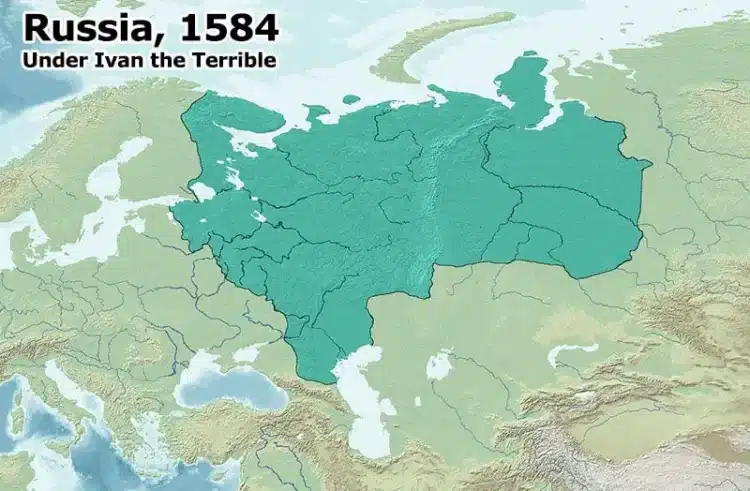
Russia – expansion to 1584.
More GeoHistories

Riga: A History in Districts
Riga, the capital city of Latvia, boasts a rich history and diverse architectural heritage. Among its many districts, Mežciems, Purvciems, Grīziņkalns, Centrs, and Vecrīga stand…
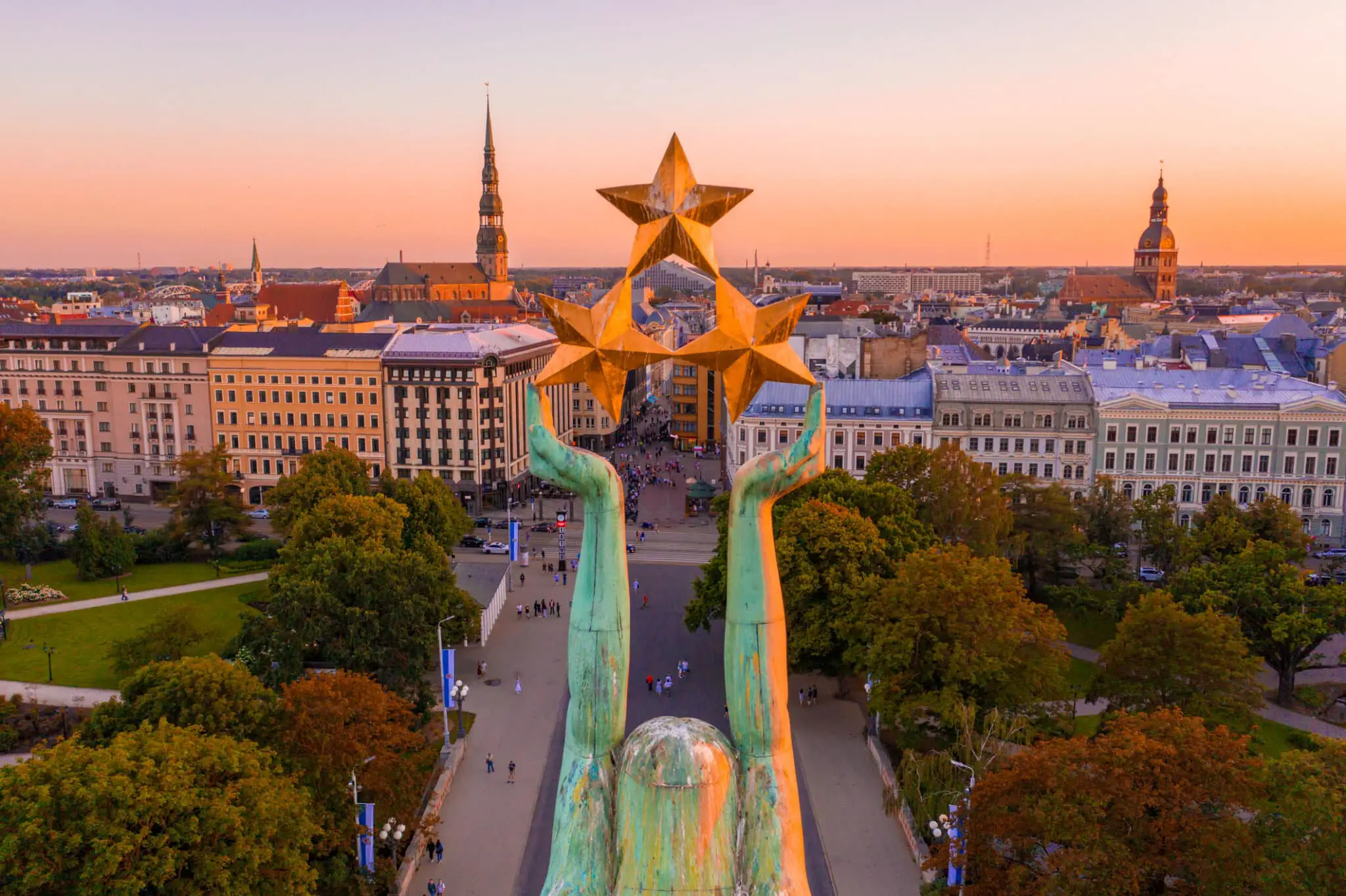
Latvia: A Case Study of Colonization and Independence
Latvia is a small country on the Baltic Sea coast. Although it has maintained a distinct language and culture for hundreds of years, it has…
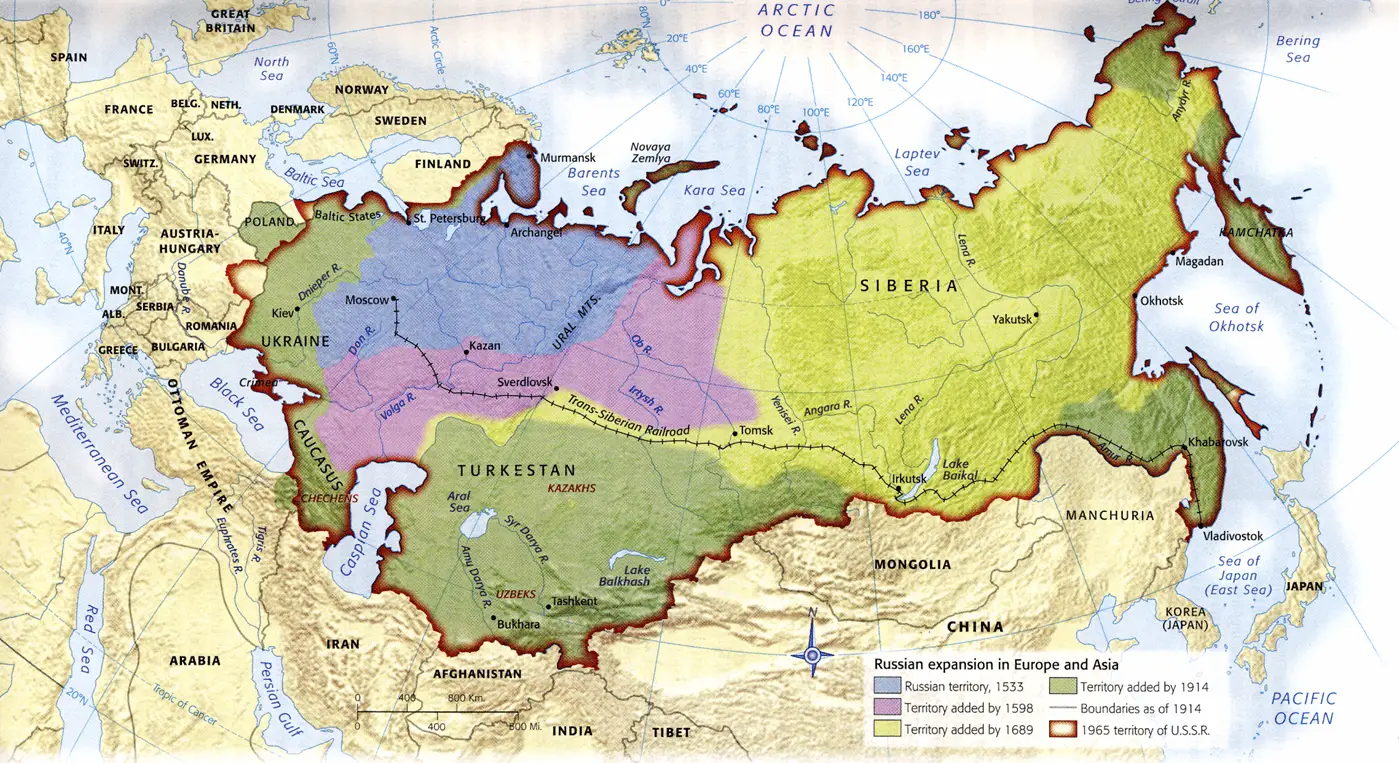
Moscow is not just a city. It was a fort that became a city, that became a state, that became an empire, that became a…
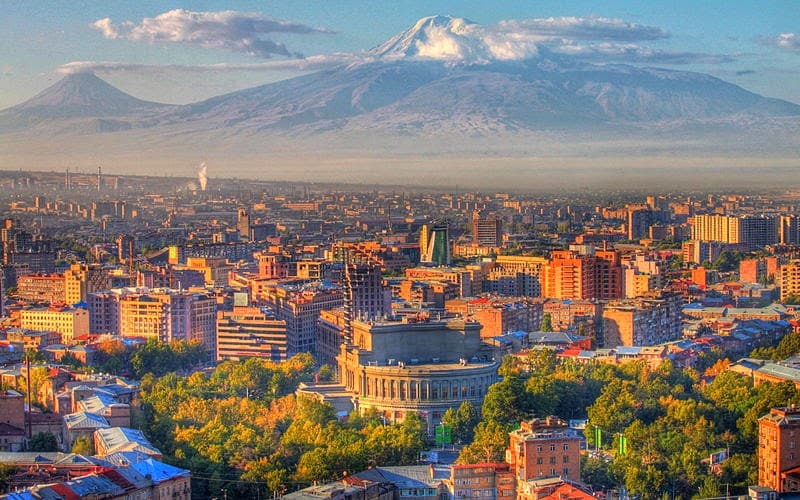
Armenia: A Global People
The Modern Republic of Armenia lies in the turbulent south Caucuses. Although the Armenians as a people have existed for thousands of years, they have…
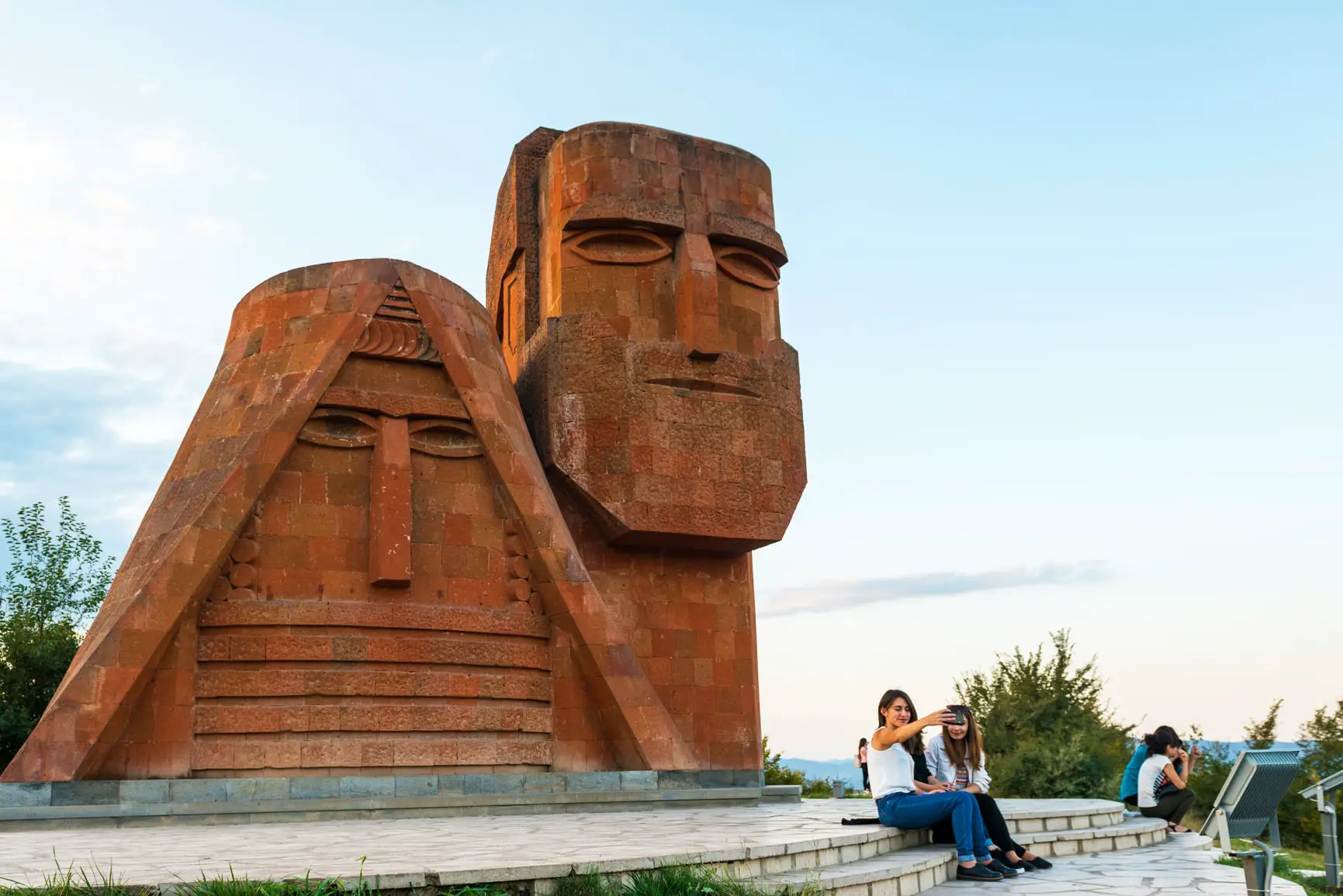
Nagorno-Karabakh: The Volatile Core of the South Caucasus
The Republic of Nagorno-Karabakh is one of four frozen conflicts that emerged after the collapse of the Soviet Union. Legally recognized as a part of…
About the Author
Josh Wilson
Josh has been with SRAS since 2003. He holds an M.A. in Theatre and a B.A. in History from Idaho State University, where his masters thesis was written on the political economy of Soviet-era censorship organs affecting the stage. He lived in Moscow from 2003-2022, where he ran Moscow operations for SRAS. At SRAS, Josh still assists in program development and leads our internship programs . He is also the editor-in-chief for the SRAS newsletter , the SRAS Family of Sites , and Vestnik . He has previously served as Communications Director to Bellerage Alinga and has served as a consultant or translator to several businesses and organizations with interests in Russia.
Program attended: All Programs
View all posts by: Josh Wilson

- Service & Refit
- Baltic Yachts Rendezvous
There can be few yacht builders like PG Johansson, who can boast an unbroken career with the company he co-founded almost 50 years ago. In that time PG Johansson has witnessed every twist and turn of a colourful, exciting and technically pioneering industry accumulating a wealth of fascinating stories, some familiar, some still untold. In this blog PG will be recalling his experiences of the yachts he has built, the people he has met and some of the more unusual events on the journey to turning clients’ dreams into reality.
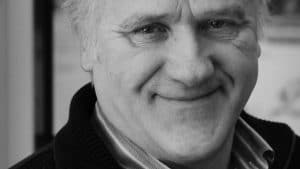
5 March 2024
Tide magazine: from land to sea.
Featuring a contemporary, warm and crafted look by Swedish architects Andreas Martin-Löf Arkitekter, the 34m sailing yacht ZEMI is a fine example of how shore-side designers can adapt to create stunning, boundary-pushing yacht interiors Forward-thinking shipyards and owners are becoming increasingly creative and inviting designers...

12 February 2024
Baltic yachts appoints new chief executive officer.
The world’s leading advanced composite yacht builder Baltic Yachts, Finland announces the appointment of new CEO, Tom von Bonsdorff, who joined the company on 5th February, 2024. With a successful background in management for Swedish automotive giant Volvo and more recently for Kesko, where he...
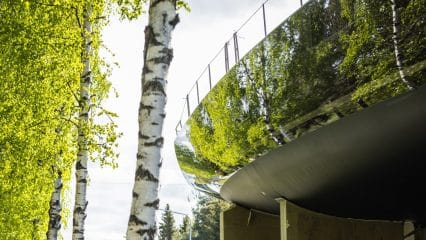
23 January 2024
Tide magazine: baltic yachts hits 50.
At the crest of boat-building since 1973, founder PG Johansson looks back at the making of Baltic Yachts Fifty years is a long time in anybody’s book, but doubly so in the gruelling world of boatbuilding. Simply in reaching its half-century, Finland’s Baltic Yachts is...
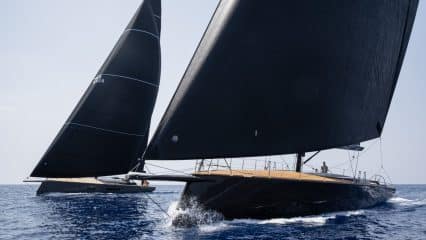
18 January 2024
Café racer fleet expands as fourth baltic 68 is sold.
Baltic Yachts has announced the sale of its fourth Baltic 68 Café Racer with the new yacht due to be delivered in early 2025 The success of the Javier Jaudenes-designed, high performance day sailer began with Pink Gin Verde in 2021, so called because Baltic...

12 January 2024
For the Baltic Family 2023 was a year filled of celebrations to mark the company’s foundation 50 years ago and recognize its success not only through the many boats it has built, but also the very special people involved. One of the many highlights...
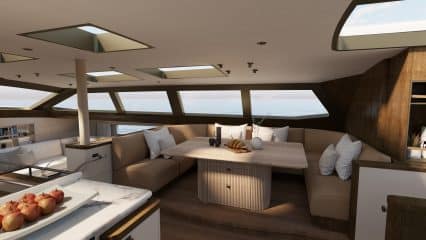
16 November 2023
Baltic 175 gets a makeover.
The iconic Baltic 175 ex-Pink Gin is currently undergoing a 10-month refit at the company base in Jakobstad, Finland which will result in a décor change throughout the accommodation and sail plan and deck gear upgrades to further exploit her sailing potential. The yacht’s new...
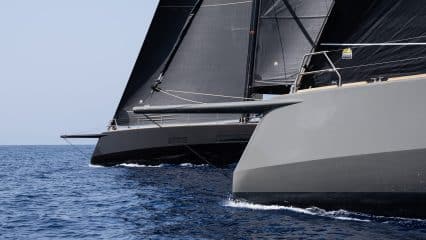
10 November 2023
Tide magazine: take two.
Baltic Yachts created quite a stir when it launched its 68 Café Racer, Pink Gin Verde. Now hull number two, Open Season, is on the water and the devil is in the difference Every now and again a yacht comes along that makes waves: case...
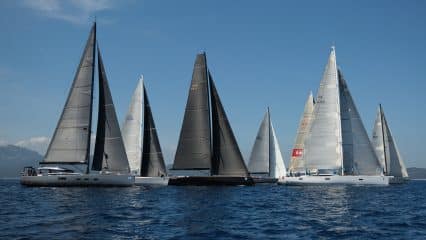
17 October 2023
The baltic family celebrates 50 years of yacht building with spectacular rendezvous regatta.
A fleet of 29 yachts and more than 400 guests, owners and crew recently enjoyed three days of sailing and celebration in near-perfect conditions in Sardinia as they marked the 50th anniversary of Baltic Yachts, the world’s leading advanced composite sailing yacht builder. Returning to...
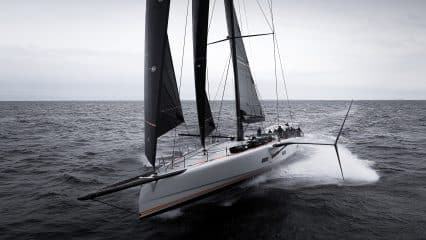
27 September 2023
Baltic 111 raven reaches sustained speeds in high twenties as successful trials are completed in finland.
Early sailing trials for the foil-assisted Baltic 111 Raven have been described as ‘very successful’ as the super-lightweight sloop showed impressive reliability and reached sustained speeds in the high 20s during 10 consecutive days of sailing off Baltic Yachts’ head-quarters in Jakobstad, Finland The revolutionary...
We’re constantly updating our website to bring you news of launchings, new commissions and Baltic inspired innovation.

IMAGES
COMMENTS
As a co-founder of Baltic Yachts, Nyfelt saw more than 550 sailing yachts, sailing superyachts, and motoryachts depart its sheds. They include projects like the Baltic 146 Custom, Path. He played a strategic role in the shipyard's overall development, including using new materials and methods. For instance, in the late 1970s, Baltic Yachts ...
Our long-term Baltic Yachts family member, friend, colleague and one of the Baltic Yachts' original founders, Jan-Erik "Janne" Nyfelt had passed away. Baltic Yachts lost a person that has contributed greatly to what Baltic Yachts is today. A great loss for the company and for me personally the loss of a person, a friend, that I have held in ...
Finnish shipyard Baltic Yachts has announced the death of its co-founder Jan-Erik "Janne" Nyfelt on January 28. Nyfelt was one of the five founders of the shipyard in 1973 and has "contributed greatly to what Baltic Yachts is today", the yard said in a statement. Nyfelt's career in boatbuilding began at a young age when he worked alongside ...
As Baltic Yachts approaches its 50 th birthday, co-founder and yacht building polymath Per-Göran 'PG' Johansson recalls some of the key moments in the company's eventful history . There can be few yacht builders who can boast an unbroken career with the company he co-founded almost 50 years ago. In that time PG Johansson has witnessed ...
Annabelle Fox. According to a statement from Baltic Yachts, one of the original founders of the shipyard, Jan-Erik 'Janne' Nyfelt, passed away on Saturday 28 th January 2023. The statement from Baltic Yachts reads, "Baltic Yachts lost a person that has contributed greatly to what Baltic Yachts is today.
Baltic Yachts was founded with a mission to make sailing boats faster, stiffer, lighter and better. They've pursued that original goal relentlessly ever since. ... One of the key figures in the story of Baltic Yachts, co-founder Jan- Erik Nyfelt, passed away on 28 January. A highly respected senior foreman in the yard from 1973 to 2002 ...
In just five decades Baltic Yachts has evolved from respected series production boat builder to the world's best composite custom yacht manufacturer, the go-to yard for innovation, performance and a hand-crafted finish second to none. ... reflected everything Baltic's founders stood for - she was comparatively light, stiff and fast and ...
23 January 2024. At the crest of boat-building since 1973, founder PG Johansson looks back at the making of Baltic Yachts. Fifty years is a long time in anybody's book, but doubly so in the gruelling world of boatbuilding. Simply in reaching its half-century, Finland's Baltic Yachts is laying claim to a place near the top of the industry ...
Baltic Yachts is a shipyard specialized in sailing yachts. It is located in the municipality of Larsmo in Finland, where it is the largest employer. The shipyard was established in 1973 and now produces sailing yachts between 50 feet (15 m) and 197 feet (60 m) in length. Advanced and light materials, such as carbon fiber and Kevlar are used in ...
Jan-Erik Nyfelt, known as "Janne" to his colleagues, passed away on January 28 2023. Nyfelt was one of the five co-founders of the Finnish shipyard Baltic Yachts and remained a very active member of the firm until his retirement. "Baltic Yachts has lost a person that contributed greatly to what Baltic Yachts is today," says fellow ...
Jan-Erik Nyfelt, one of the founders of Baltic Yachts has passed away, according to a statement by the shipyard. People In memoriam: Jan-Erik Nyfelt, founder of Baltic Yachts. Written by Alexander Griffiths. 2 Feb 2023 | 15:30. Loading... Newsletter. Subscribe. Follow Us. Shop.
4 December 2013. Baltic Yachts is celebrating 40 years in business this year, its longetivity based on a reputation for using the latest technology to create high-performance sailing yachts. The Finnish yard was founded in 1973 by five employees of Nautor's Swan who wanted the freedom of their own company to try out ultra-modern methods of ...
Just one year later, the Baltic 39 series sold out, becoming Baltic Yachts' most successful, leading to 75 sales. She combined fast upwind performance with family-friendly amenities. Unfortunately, the tide turned for the yard's founders in the late 1970s.
Working alongside naval architects C&C, Baltic Yachts continued to release a string of industry-leading designs, including the BALTIC 43 which became their most commercially successful yacht, according to the founder. Today, Baltic Yachts continues to pride itself on its innovative designs, industry-leading research and unique philosophy, all ...
LIGHTER, STIFFER, FASTER, GREENER - TOGETHER. Baltic Yachts is the world's leading builder of advanced composite yachts. Our highly skilled workforce uses leading edge marine technology and traditional craftsmanship to create award-winning yachts. Each yacht is unique, unmatched in its quality, unmatched in its performance.
The founders' goal was to build sailing yachts that were "faster, stronger and lighter" than the competition utilising exotic construction materials including carbon fibre and high-tech yacht-building method. After launching the Baltic 46 and 33 production sailing yacht series, Baltic Yachts delivered its first custom yacht in 1975.
Princess Yachts provides motorboats and yachts. The company designs and manufactures yachts focused on the mid to large-size yacht market. It offers a range of sports, ships, and motor yachts. The company was founded in 1965 and is based in Plymouth, U.K.
The Dilbar, a luxury yacht owned by the Russian billionaire Alisher Usmanov, sails in the Bosphorus in Turkey. ... Leonid Mikhelson is the founder and chairman of natural gas producer Novatek, a ...
The building of Moskva-Volga canal made it possible to reach the White Sea and the Baltic Sea by sailing from Moscow. First ship enters lock on the Moscow-Volga Canal. Georgy Zelma/Sputnik
He was the owner of the yacht Serene. The motor yacht Serene is one of the largest yachts in the world. With a length of 134 meters (or 439 ft). She was built by Fincantieri yachts. To design of Espen Oeino. The motor yacht can accommodate 24 guests. Serene has 12 guest cabins and 30 crew cabins. She has a crew of 54.
Latvia's airBaltic, which is aiming to float on the stock market at the end of this year or in 2025, could see itself as part of a larger airline group when it has built up enough scale, its CEO ...
The world's leading advanced composite yacht builder Baltic Yachts, Finland announces the appointment of new CEO, Tom von Bonsdorff, who joined the company on 5 th February, 2024.. With a successful background in management for Swedish automotive giant Volvo and more recently for Kesko, where he led the roll-out of Finland's leading electric vehicle charging network, Tom, 53, will take ...
Geohistory: the Foundations of Moscow and the Russian State. Moscow was officially founded in 1147 by Yuri Dolgoruki, the Grand Prince of Kyiv. The name "Moscow," applied to both the new garrison and the adjacent river, may have come from the Slavic, Baltic, or even Uralic or Finno-Urgic peoples who lived in or traveled through the land for centuries before.
BALTIC YACHTS APPOINTS NEW CHIEF EXECUTIVE OFFICER. The world's leading advanced composite yacht builder Baltic Yachts, Finland announces the appointment of new CEO, Tom von Bonsdorff, who joined the company on 5th February, 2024. With a successful background in management for Swedish automotive giant Volvo and more recently for Kesko, where ...
A nautical-themed bar and restaurant is set to open in Butchertown this summer. YachtSea will be located at 111 N. Wenzel in Butcher Block, a development by Andy Blieden.